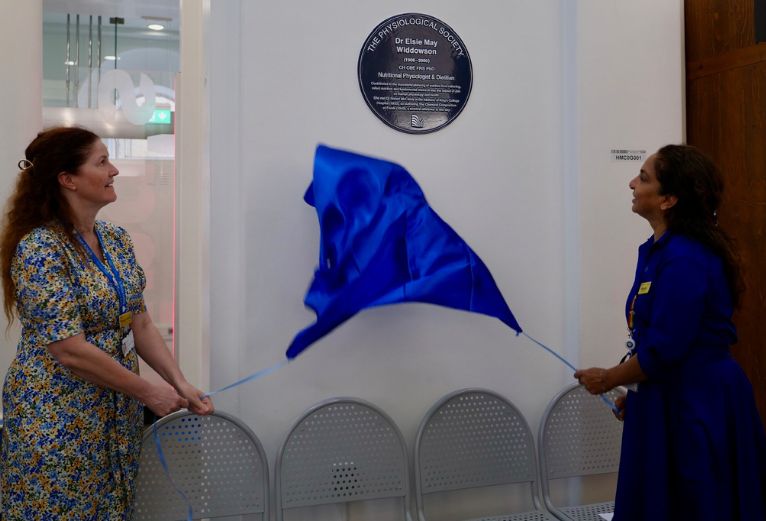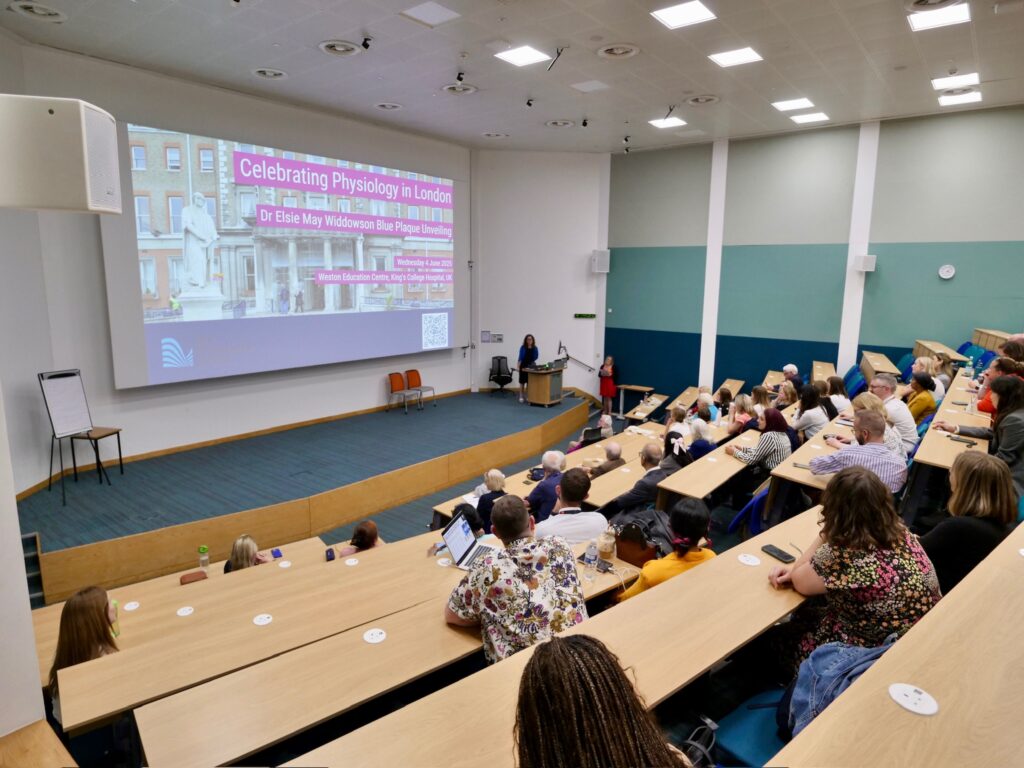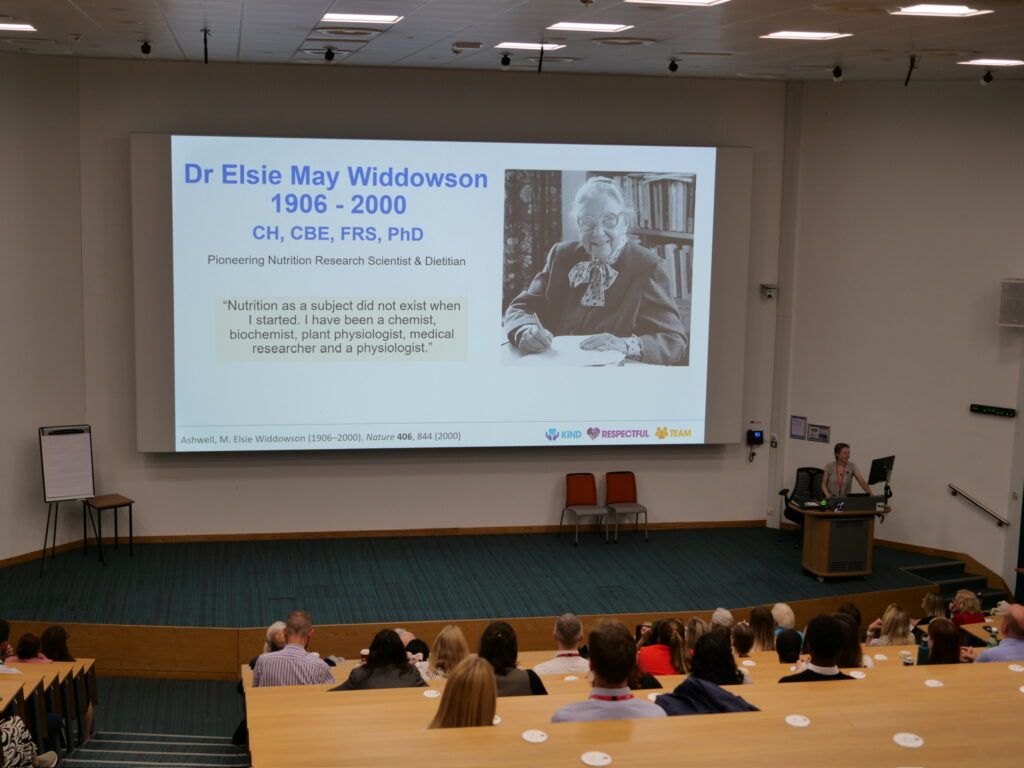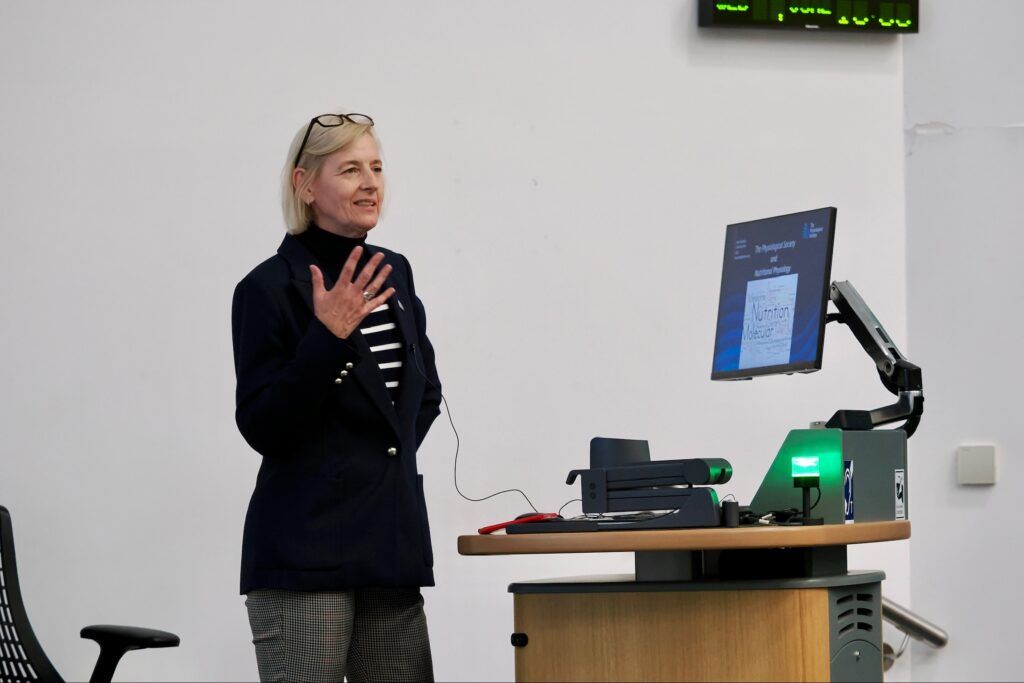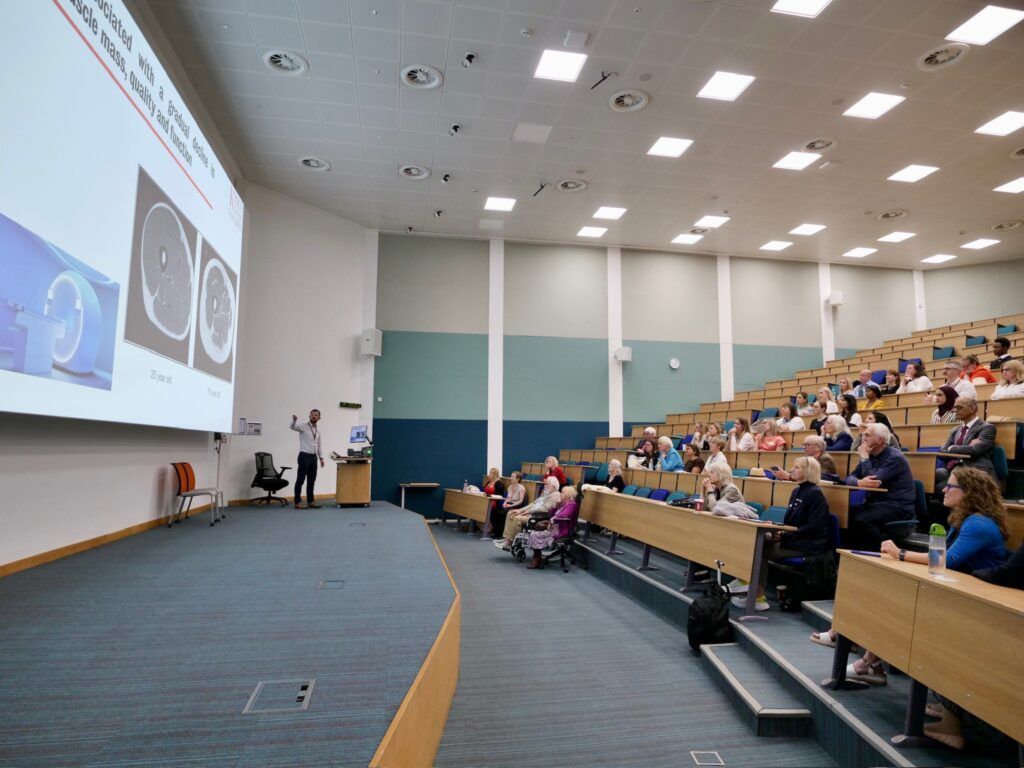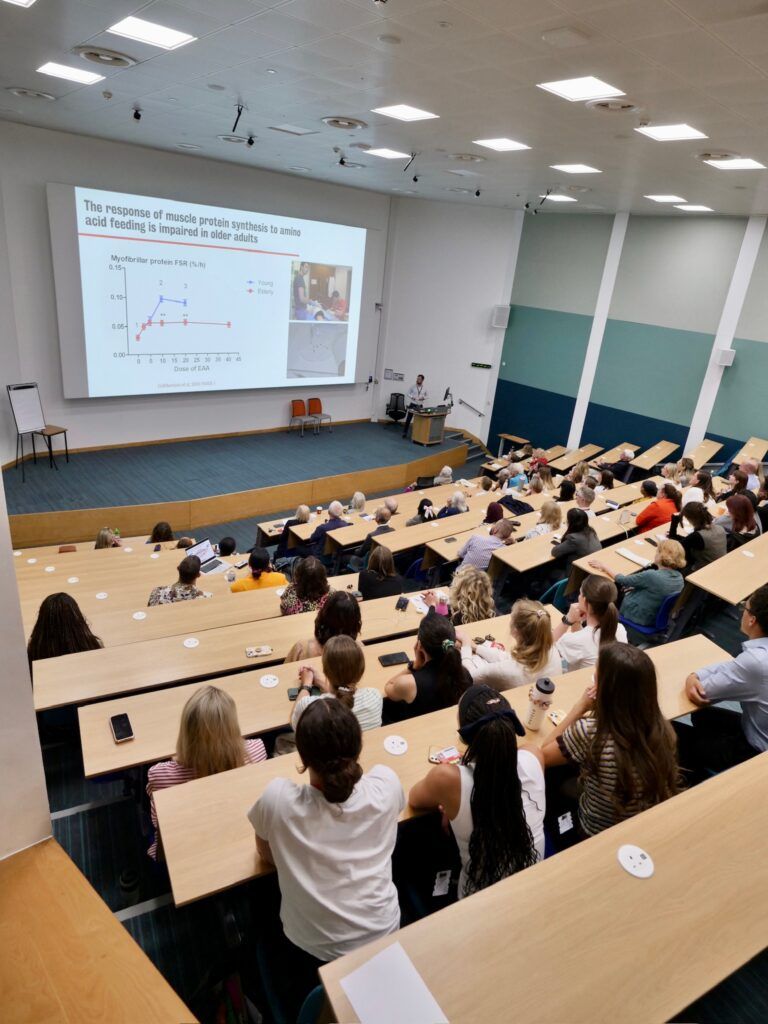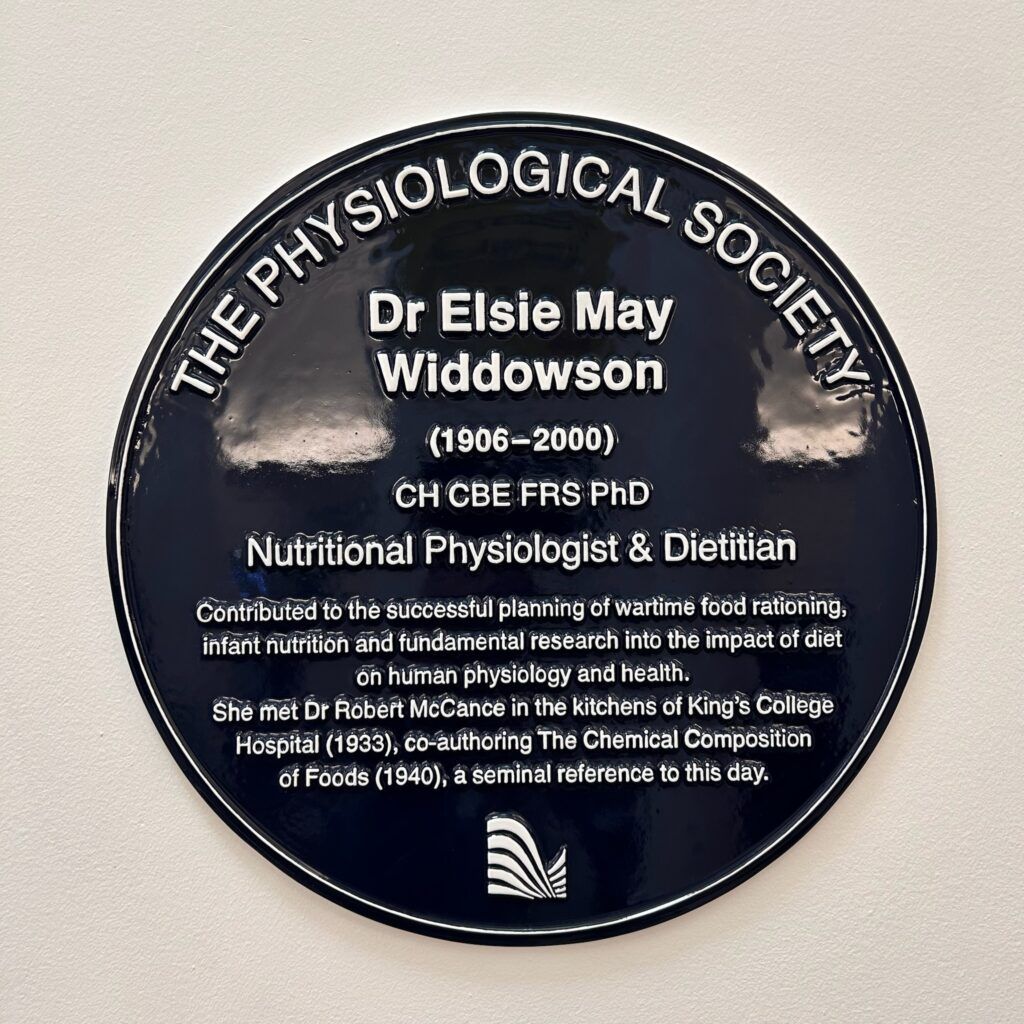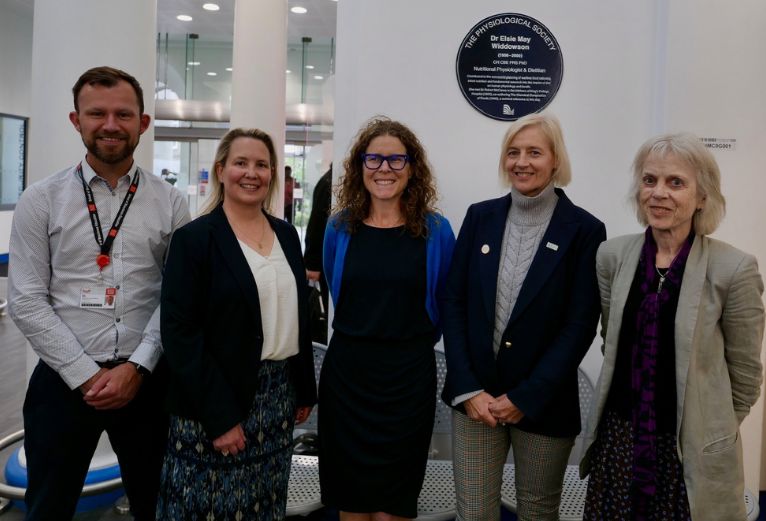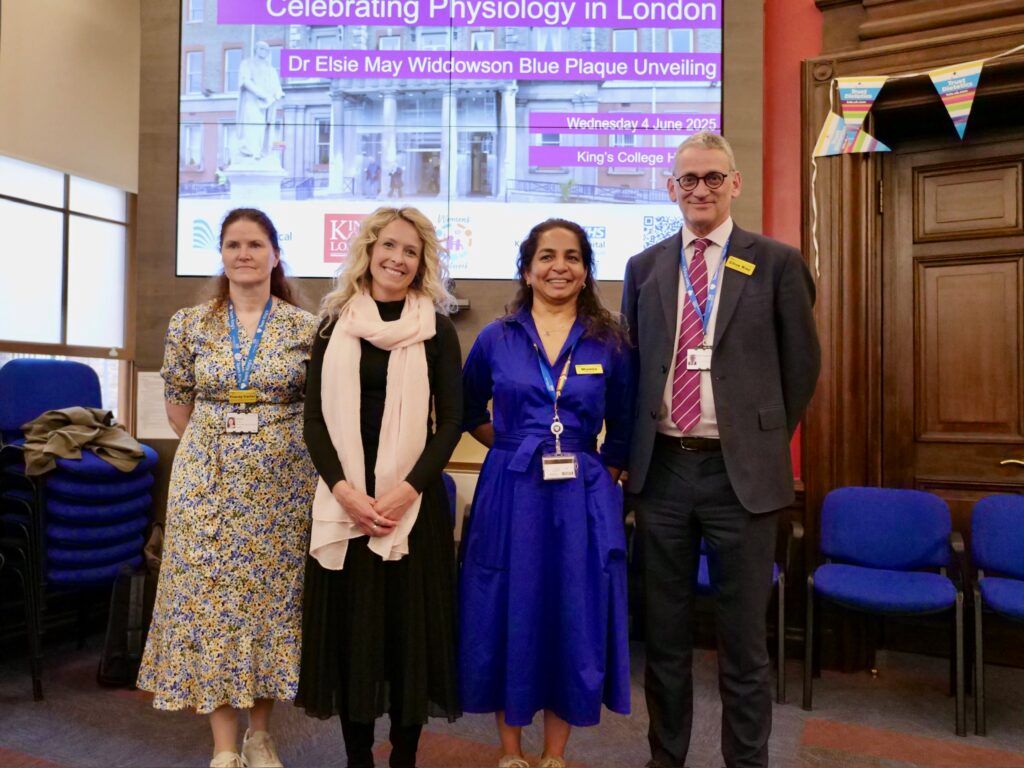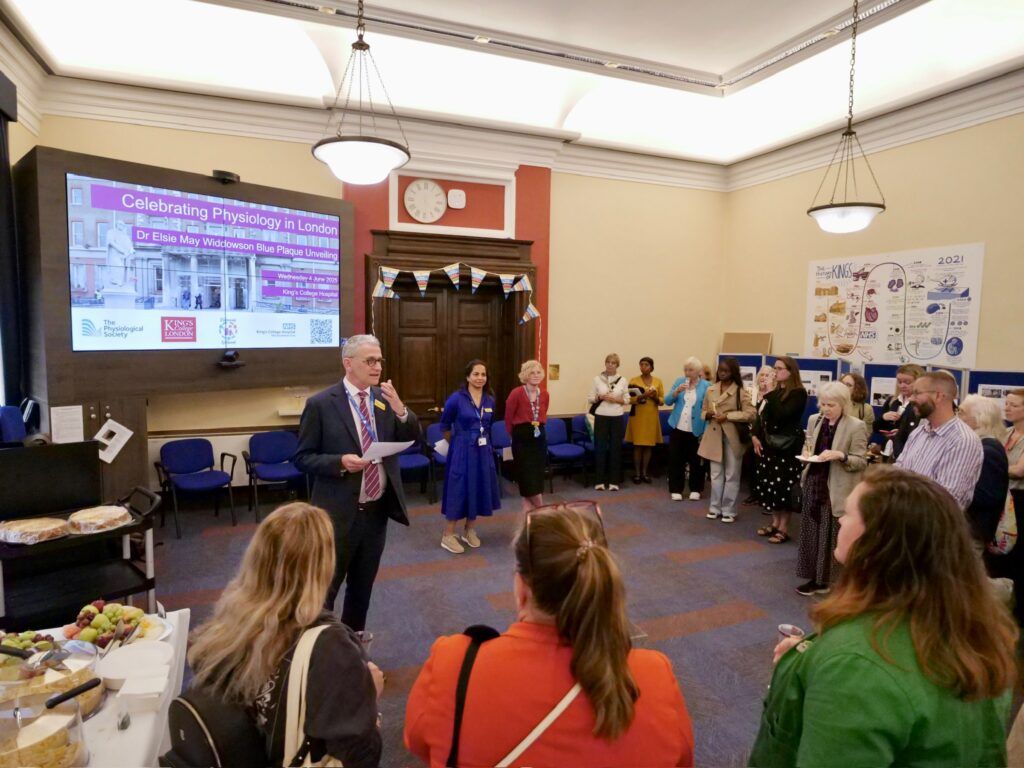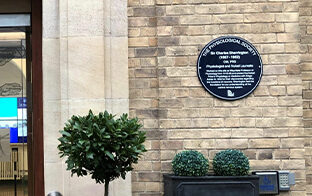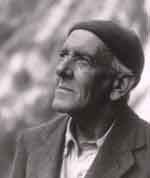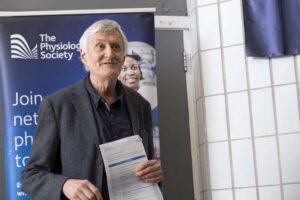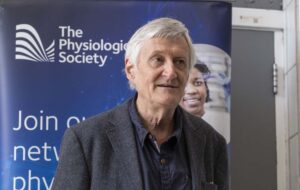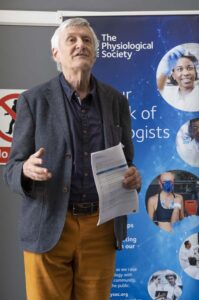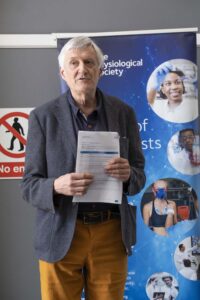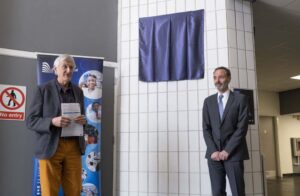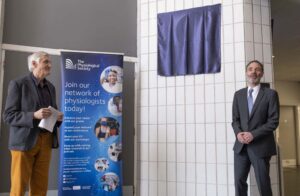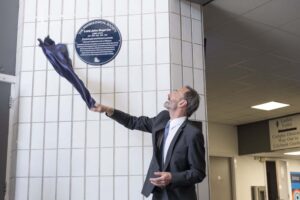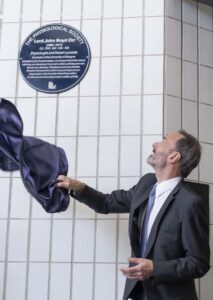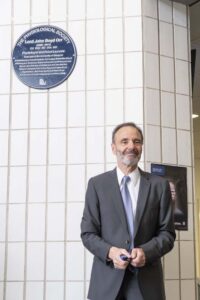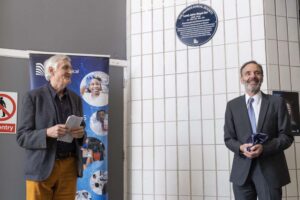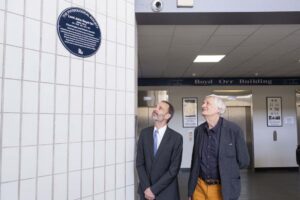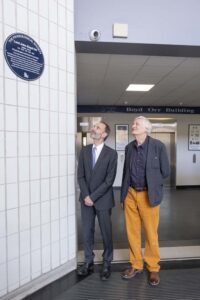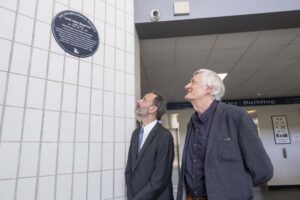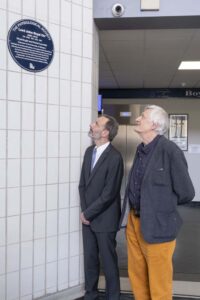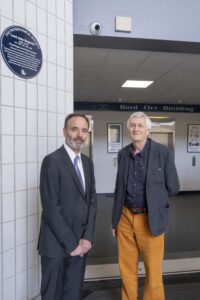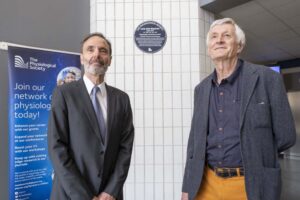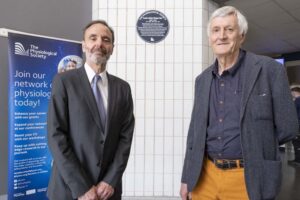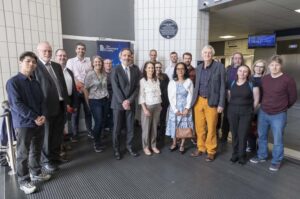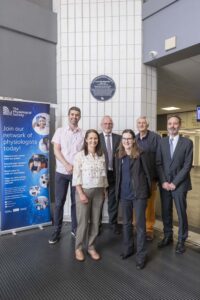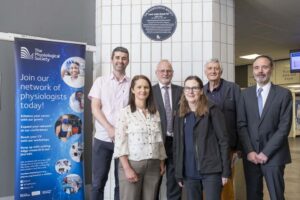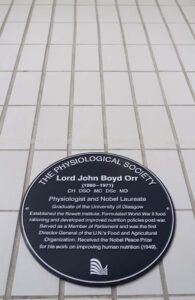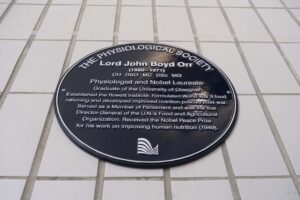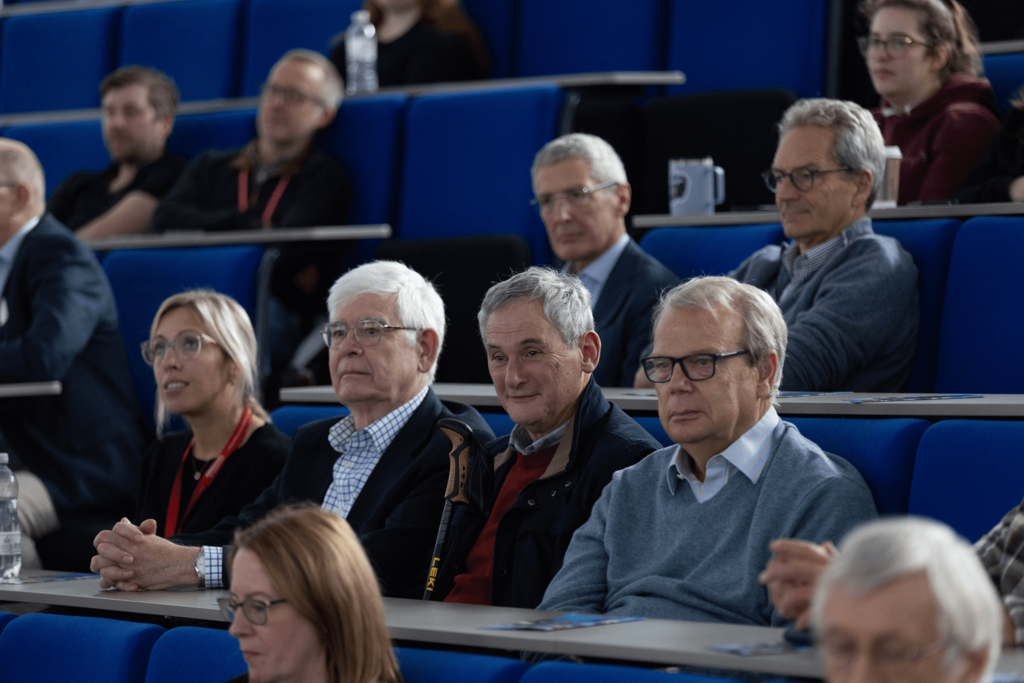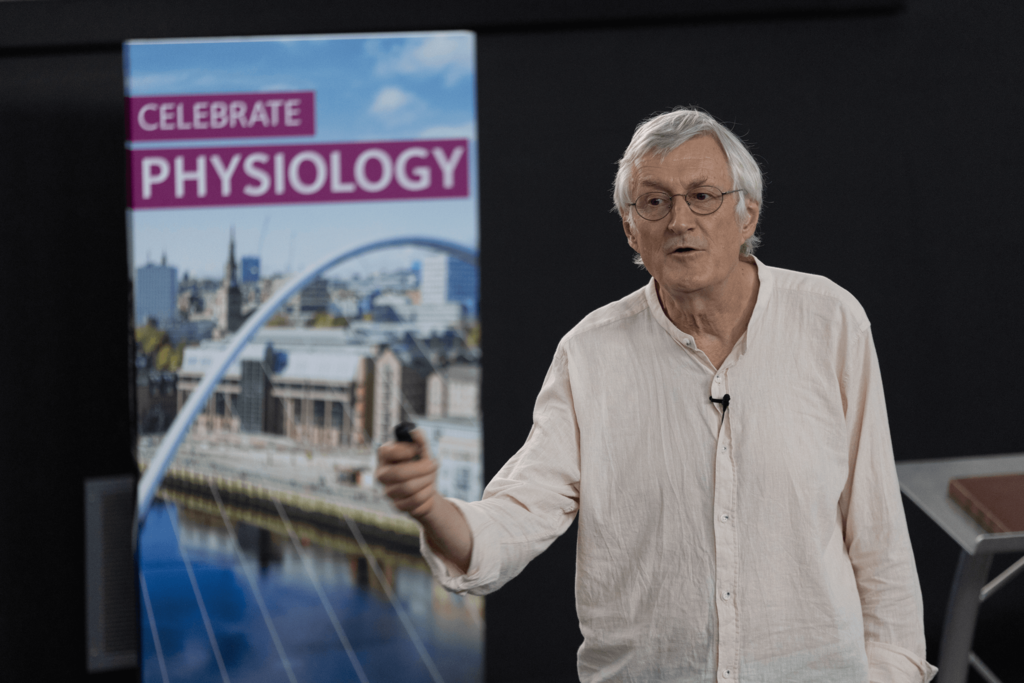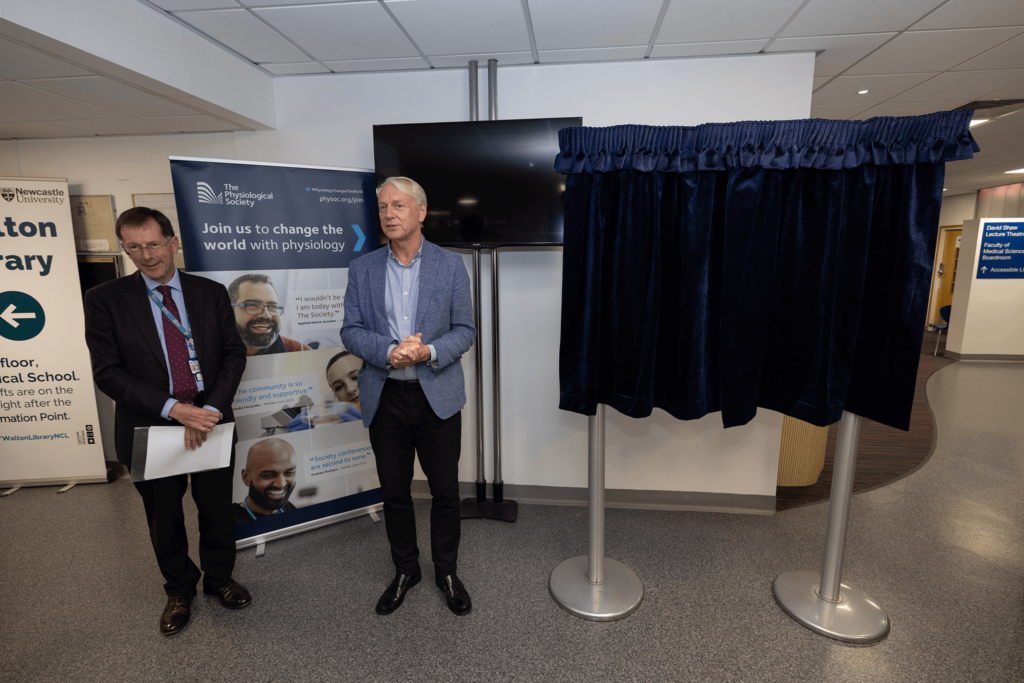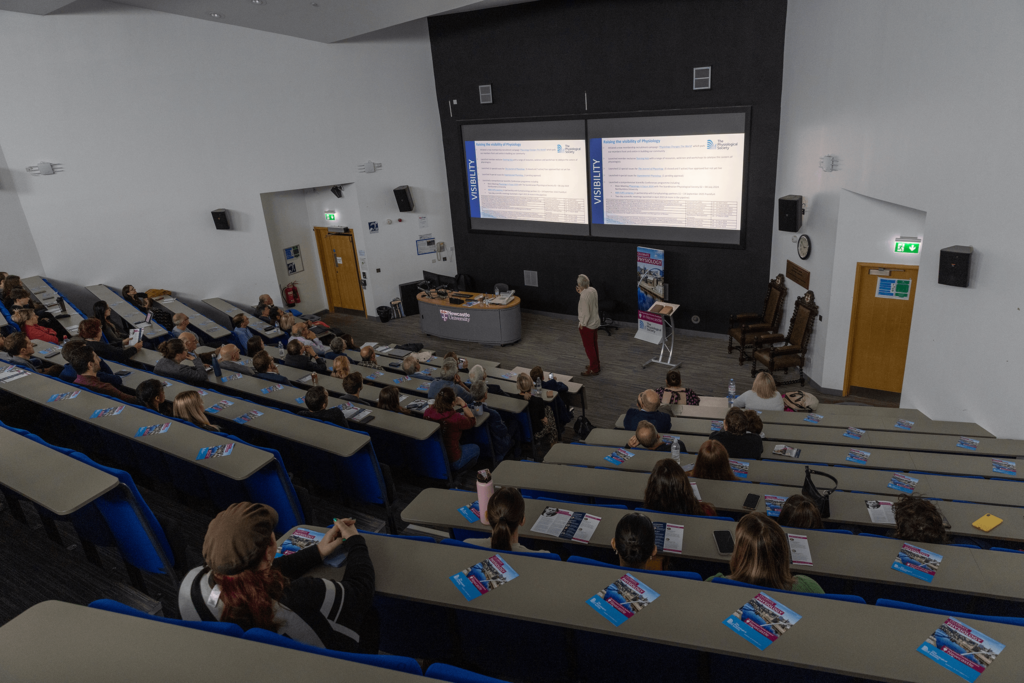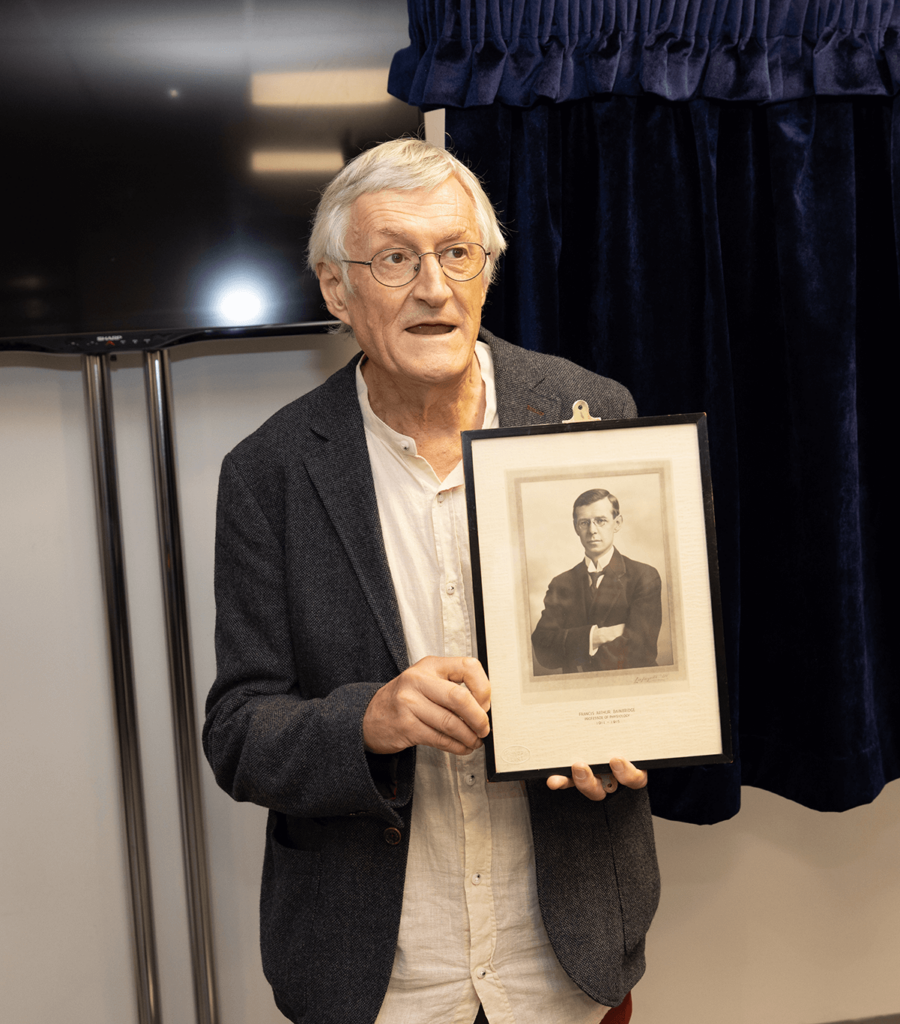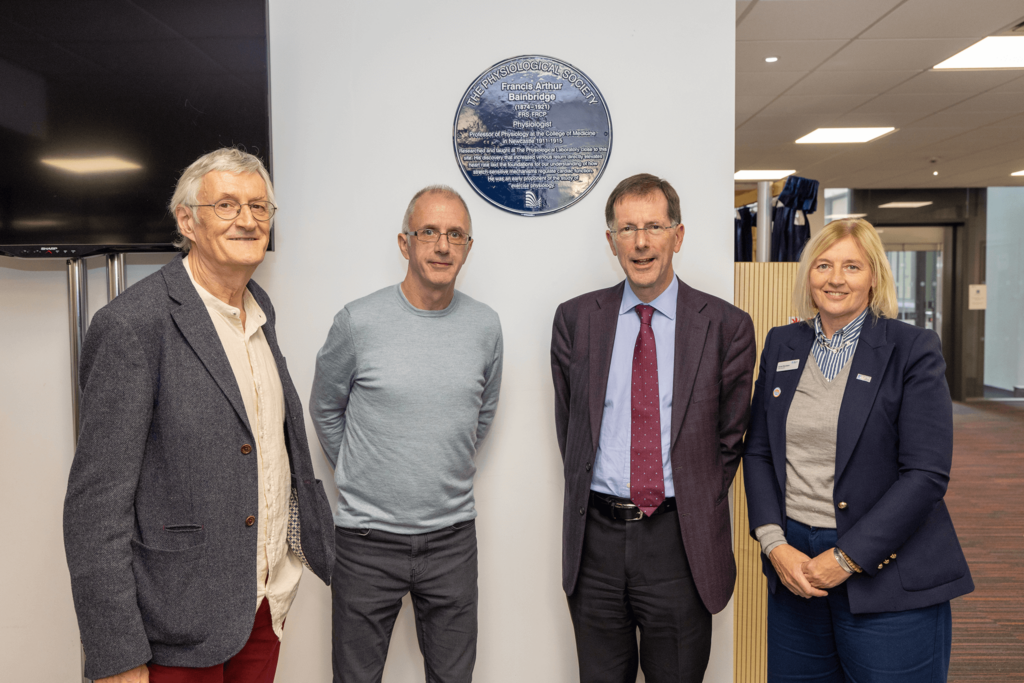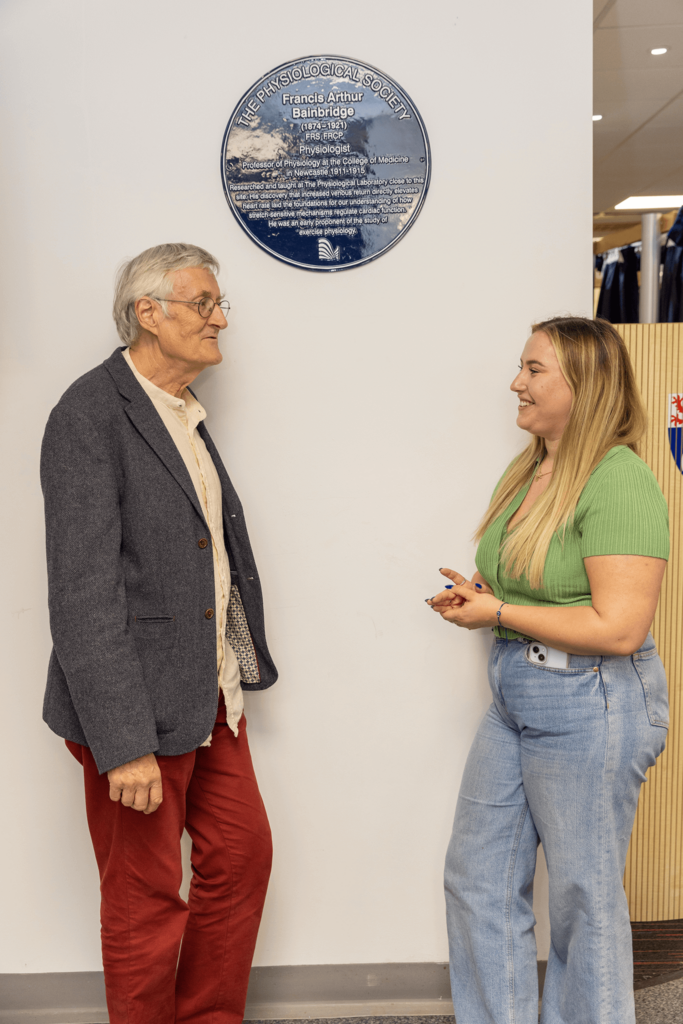Our blue plaques
The Physiological Society’s blue plaques honour outstanding physiologists who have contributed to the advancement of the discipline through their discoveries while leaving a legacy beyond their lifetime. The Society’s Blue Plaques span across the UK and Ireland:

This plaques are awarded by the Board of Trustees following recommendation from the Nominations Committee.
Sir Charles Scott Sherrington - Oxford & Liverpool
Name of person: Sir Charles Scott Sherrington
Location of plaque:
- Department of Physiology Anatomy & Genetics, University of Oxford, UK
- University of Liverpool Sherrington Building, University of Liverpool, Ashton Street, Liverpool, UK
Dates unveiled: 23 June 2021 (Oxford), 29 September 2021 (Liverpool)
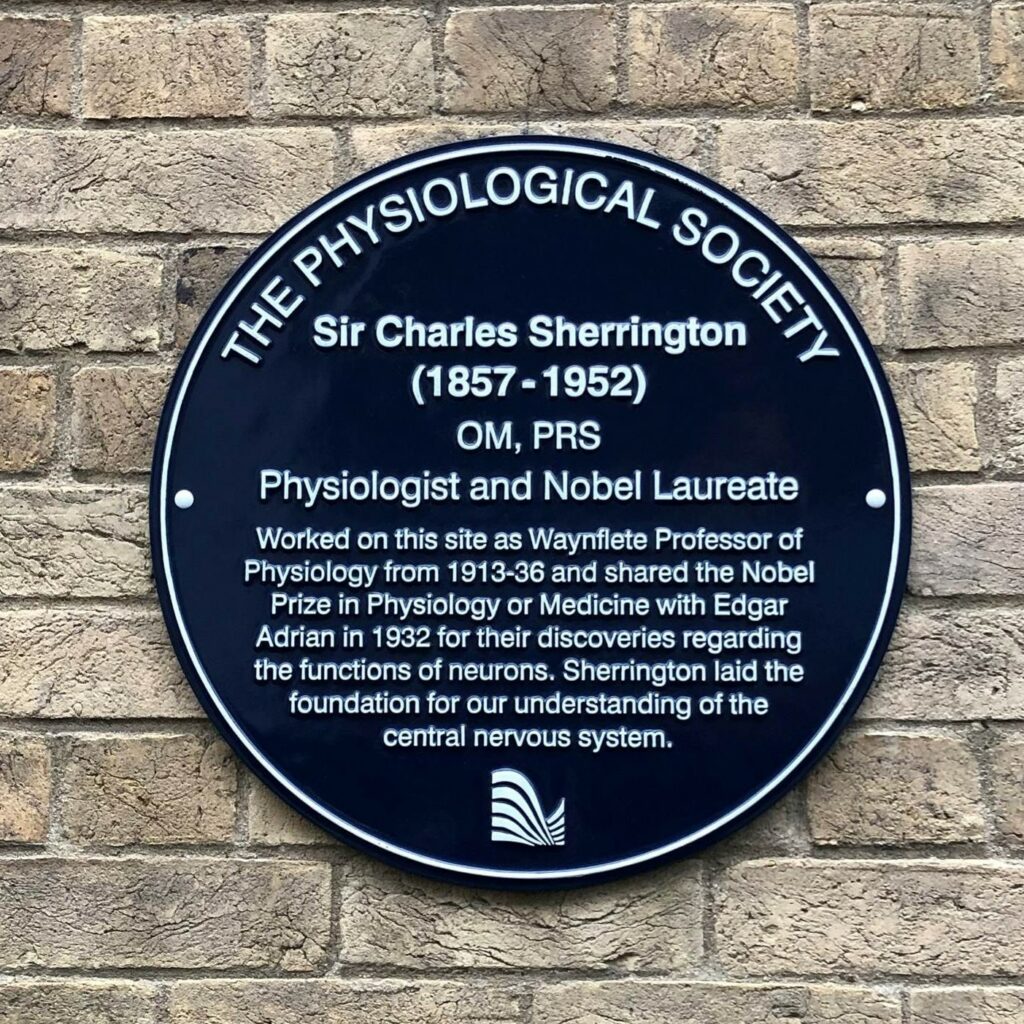
Department of Physiology Anatomy & Genetics, University of Oxford, UK
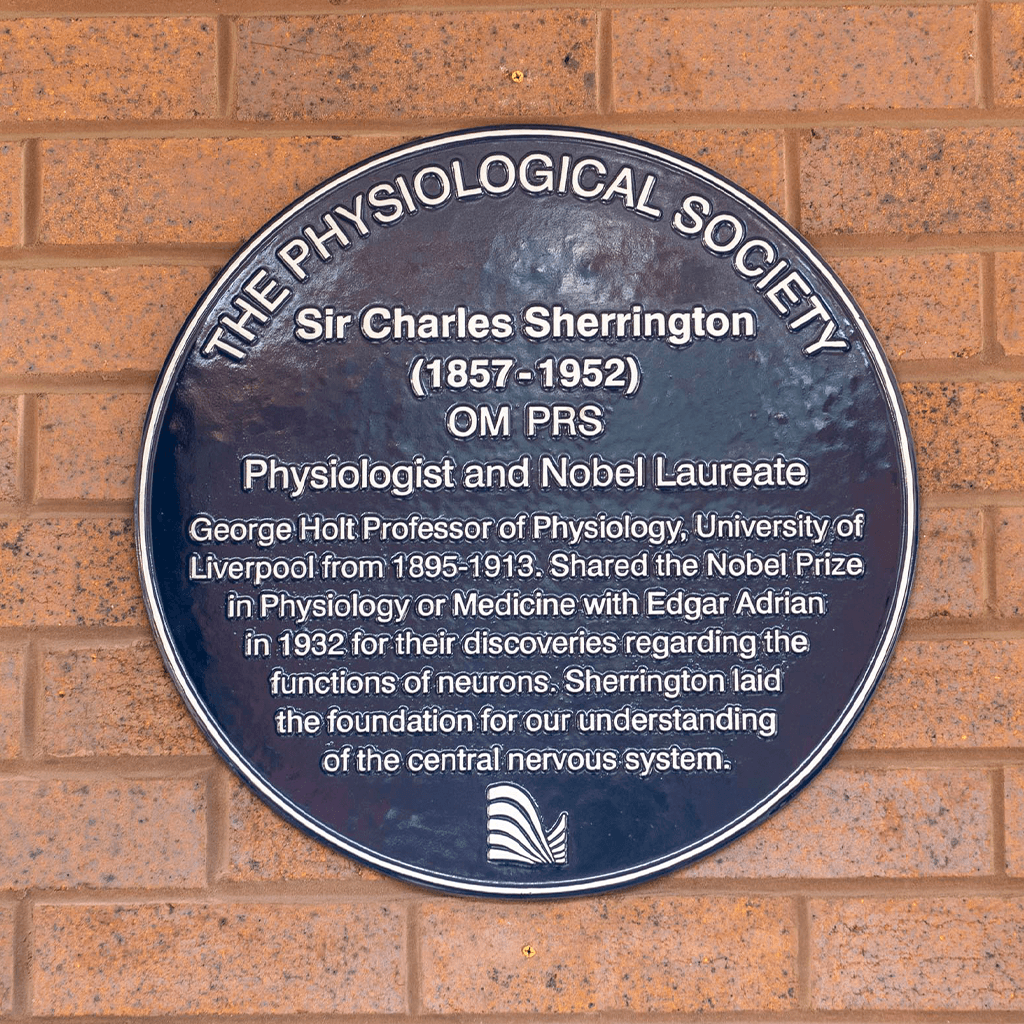
University of Liverpool Sherrington Building, University of Liverpool, Ashton Street, Liverpool, UK
Information about Sherrington:
The details of Sir Charles Scott Sherrington’s early childhood are unclear, as certain records indicate that his father and mother were James Norton Sherrington and Anne Thurtell, but others suggest Caleb Rose and Anne Sherrington. Censuses from the time indicate the latter pair were his parents, and that he was born in 1857 in Ipswich.
In Ipswich school in the 1860s, Sherrington was taught by the famous poet Thomas Ashe. From Ashe, his love of the classics grew. His father was a scholar of the classics and an archaeologist, which furthered Sherrington’s academic inclination.
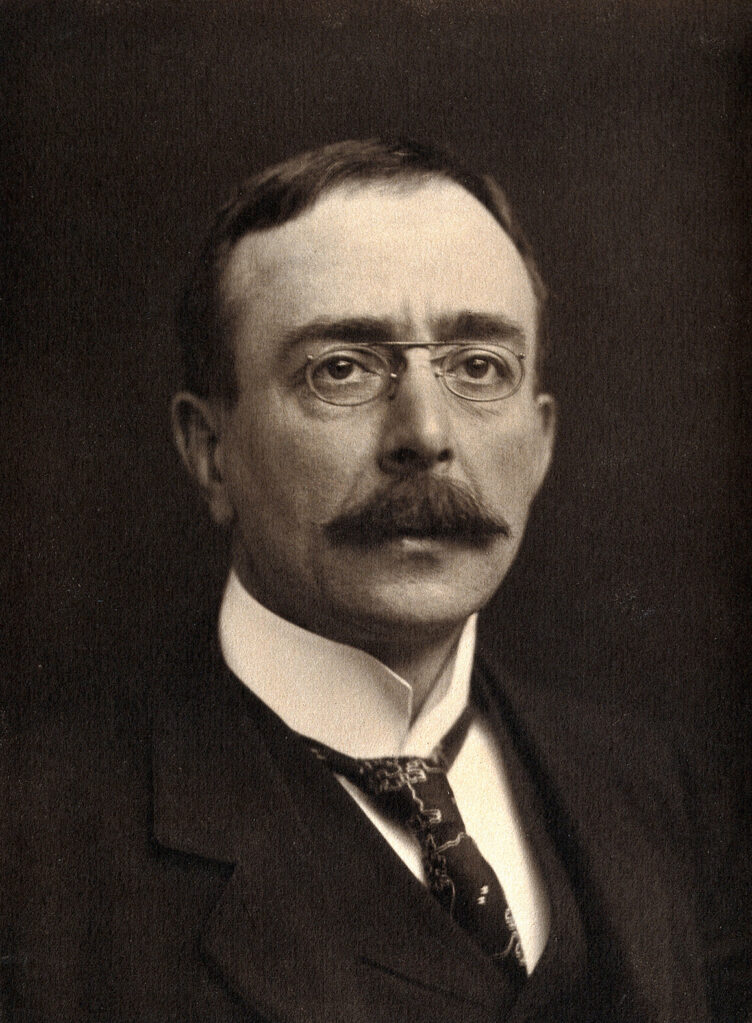
Sir Charles Scott Sherrington, Photograph
In 1876, he started studying medicine at St Thomas’ Hospital in 1876 and three years later entered Cambridge initially as a non-collegiate student. A year into his studies at Cambridge, he entered Gonville and Caius College. Among his professors at Cambridge was the famous Sir Michael Foster, the so-called “father of British physiology”.
Just a few years later in 1884, he became a member of the Royal College of Surgeons and a year after that he earned both a First Class in the Natural Sciences Tripos (the framework for teaching life science at Cambridge) with the mark of distinction, and also degree of Bachelor of Medicine and Surgery from Cambridge.
Archive footage: Sir CS Sherrington
Also in 1884, Sherrington published his first paper, with John Newport Langley, while at Cambridge. The basis of a paper was a controversy between Friedrich Goltz and David Ferrier. Ferrier argued that the cortex (the outer layer of the brain) had various functions localised throughout it whereas Goltz disagreed.
Sherrington next travelled to Spain and Italy to study a cholera outbreak, then to Berlin for a few years, and finally back to the UK, first to be as superintendent of the Brown Institute for Advanced Physiological and Pathological Research of the University of London from 1891, and then to Liverpool in 1895 to serve as Holt Professor of Physiology at Liverpool.
In 1891 Sherrington also married Ethel Mary Wright and six years later they had their one child together, Charles ER Sherrington.
One of his most famous books, “The Integrative Action of the Nervous System”, was published in 1906, and summarised almost two decades of research. It clarified that the nervous system cannot be viewed as a single interlinking network and gave an alternative explanation of synaptic communication between neurons. This book arguably changes the course of neurophysiology.
His next academic post was at University of Oxford, starting in 1913, as the Waynflete Professor of Physiology.
Sherrington received the Nobel Prize in Physiology or Medicine in 1932 with Edgar Adrian for their work on the functions of neurons. Prior to their research, it was thought that reflexes occurred as isolated activity within a reflex arc; they showed that instead, reflexes require integrated activation and showed reciprocal innervation of muscles, a principle now called Sherrington’s Law.
In 1936, he retired from Oxford and moved back to his place of birth, Ipswich. At the age of 94, he died suddenly of heart failure.
Professor Archibald Vivian (AV) Hill - Manchester
Name of person: AV Hill
Location of plaque: Coupland Building 3, The University of Manchester, Coupland Street, Manchester, M15 6FH
Date unveiled: 16 September 2021
Additional reading:
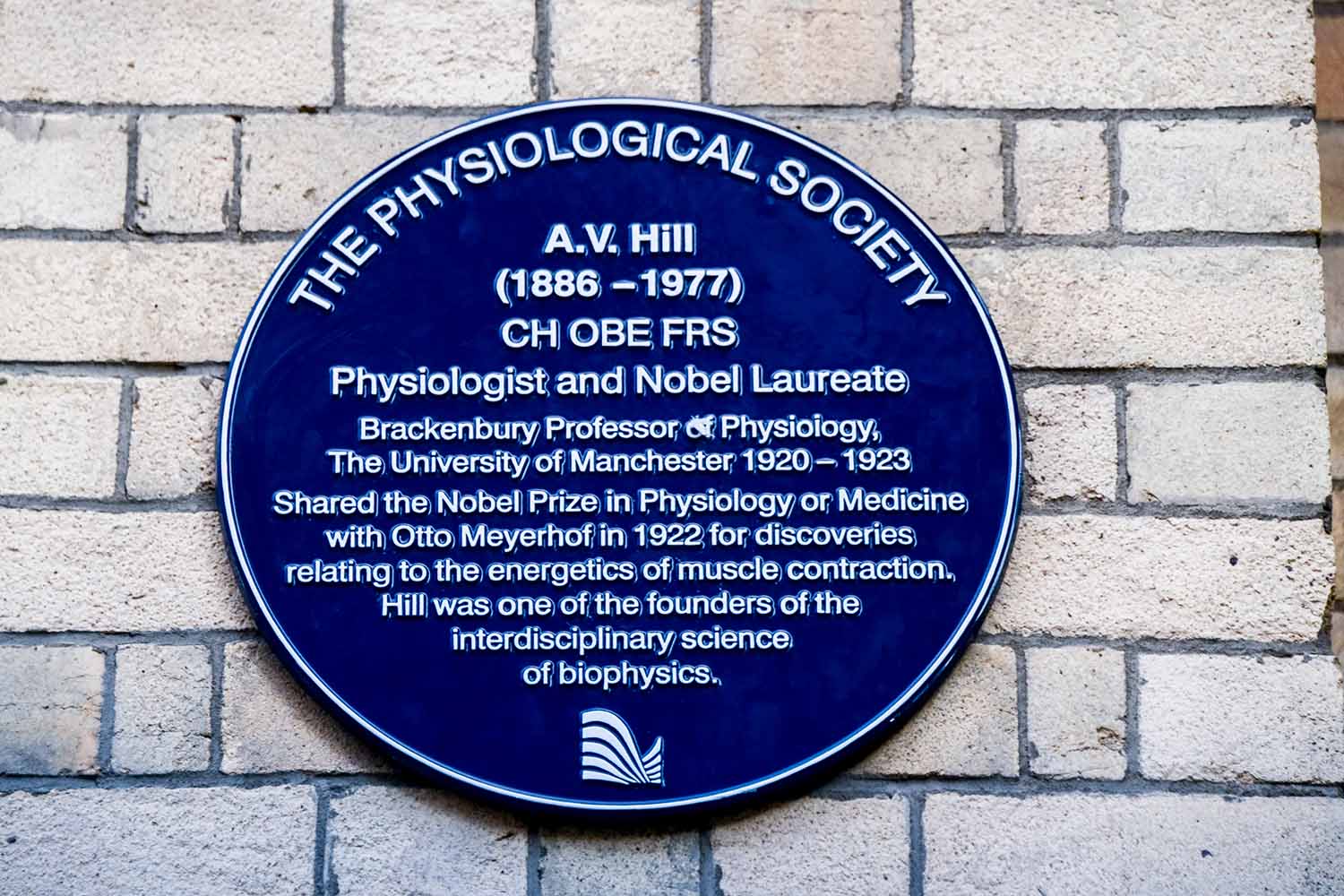
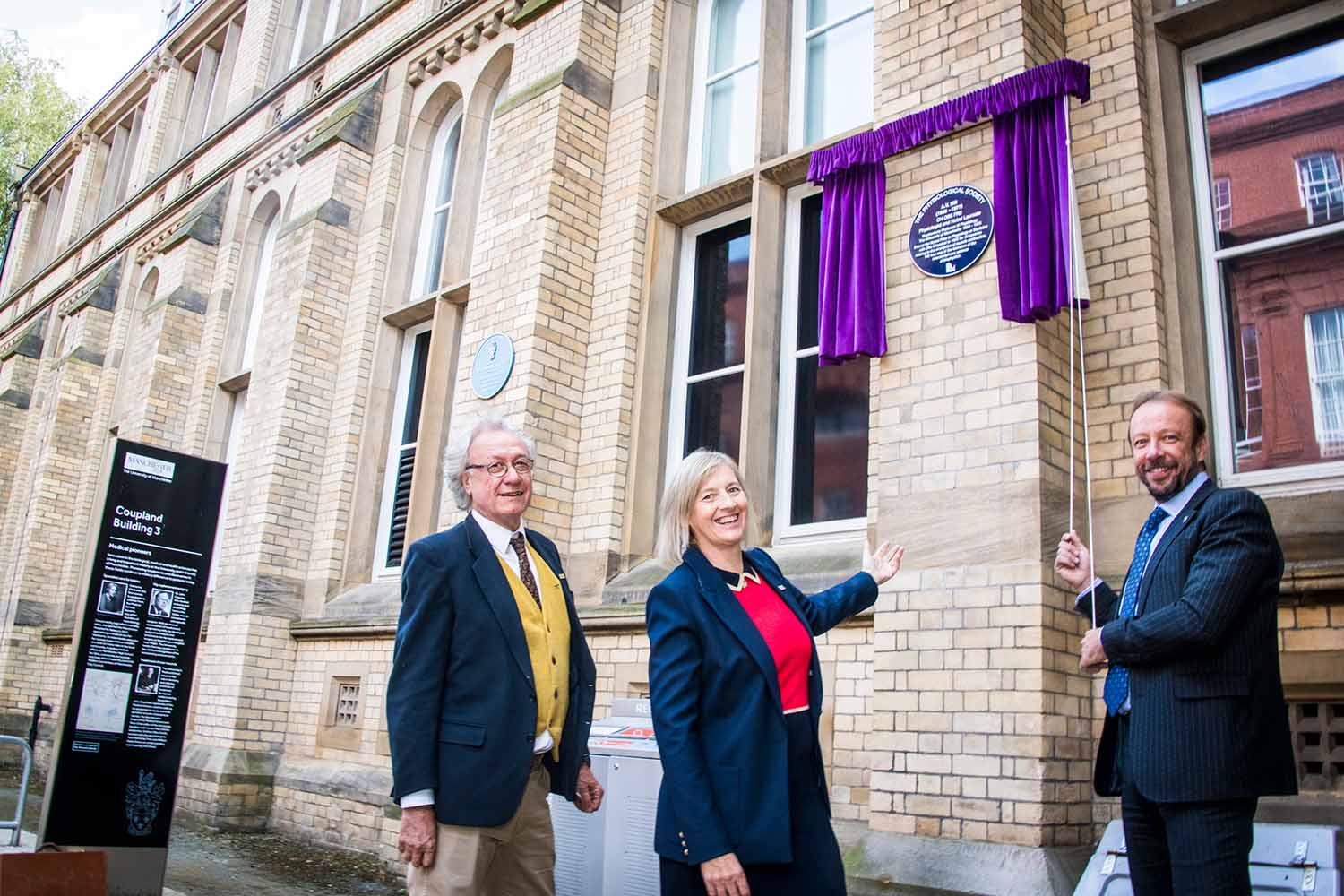
Plaque unveiling at The University of Manchester
Information about A.V. Hill
Archibald Vivian Hill, known as A.V. Hill, was born in 1886 and in 1922, at the age of just 36, was awarded the Nobel Prize ‘for Physiology or Medicine’ with Otto Meyerhoff. Hill’s Nobel citation was for ‘his discovery relating to the production of heat in muscle’. It was awarded for his studies on the relationship between muscle heat and contraction and work. He developed precise methods to measure the heat generation and showed that the initial contraction did not require oxidative metabolism. He demonstrated that oxygen is required during recovery from contraction. This oxygen debt is noticed on recovery after sprinting, for example. Hill’s work on heat production in muscle and his subsequent work relating to electrically excitable cells and to muscle function are foundations of the discipline of biophysics.
Hill made massive scientific contributions. Additional work included the eponymous Hill Equation, which is still used to report on interactions and cooperativity of binding. This work was published in 1910 as a communication to The Society. He also analysed the time-course of muscle contraction produced by nicotine and concluded that this reflected ‘a gradual combination of the drug with some constituent of the muscle’. This must be one of the earliest mentions of what we now call a receptor for a drug.
Alongside his scientific research, Hill had an active role in both World Wars, acting as a government scientific adviser before and during the Second World War. He was also a life-long humanitarian. His Nobel Prize was awarded soon after the end of the First World War and he advocated extending the invitation to The Society’s international congress to all scientists including those not from the Allied Powers.Hill also worked with Ernest Rutherford (who was in Manchester from 1907 to 1919) and William Beveridge to establish the Academic Assistance Council, which helped scientist victims of Nazi persecution. This was at a time when the events in Germany were not known to the majority of people in the UK. This organisation helped a thousand scientists escape, including 18 who went on to win Nobel Prizes, and many members of The Physiological Society.
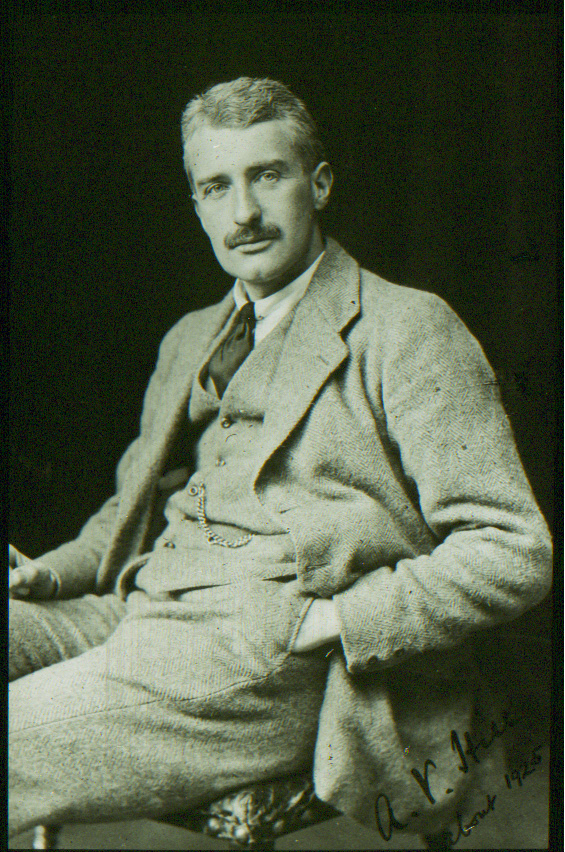
A.V. Hill, Photograph
A.V. Hill joined The Society in 1912 and filled many major roles (Secretary 1927-33, Foreign Secretary 1934-45, served many years on the Editorial Board of The Journal of Physiology). In 2016, AV Hill’s Novel certificate was gifted to The Physiological Society by the family. This gift recognised the active role Hill played in The Society throughout his scientific career.
Professor Mary Pickford - Edinburgh
Name of person: Professor Mary Pickford
Location of plaque: Old Medical School Quad, Doorway 3, University of Edinburgh
Date unveiled: 22 October 2021
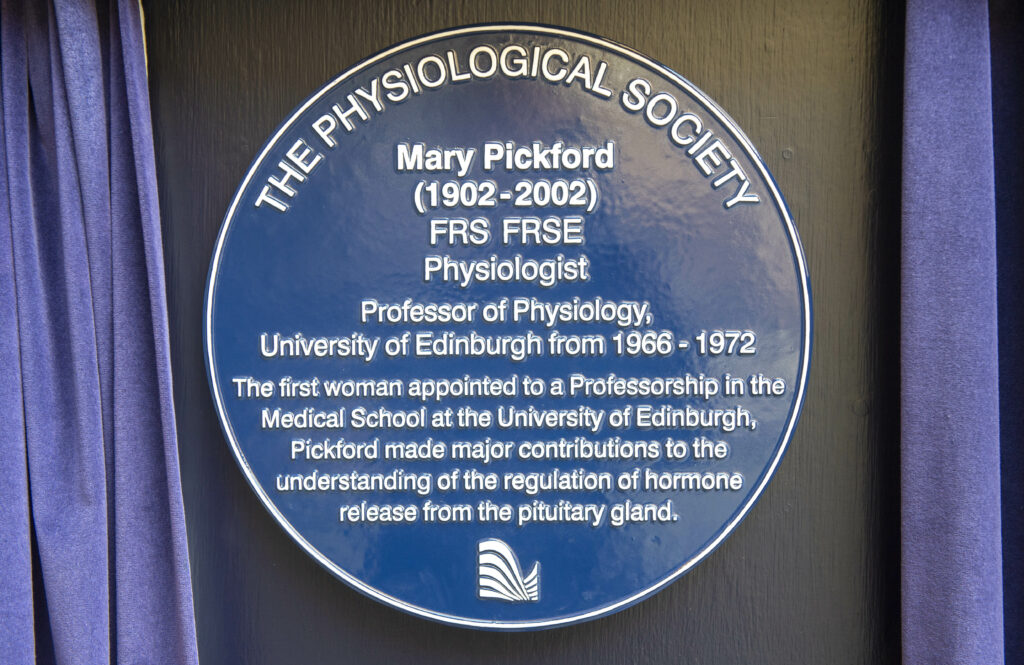
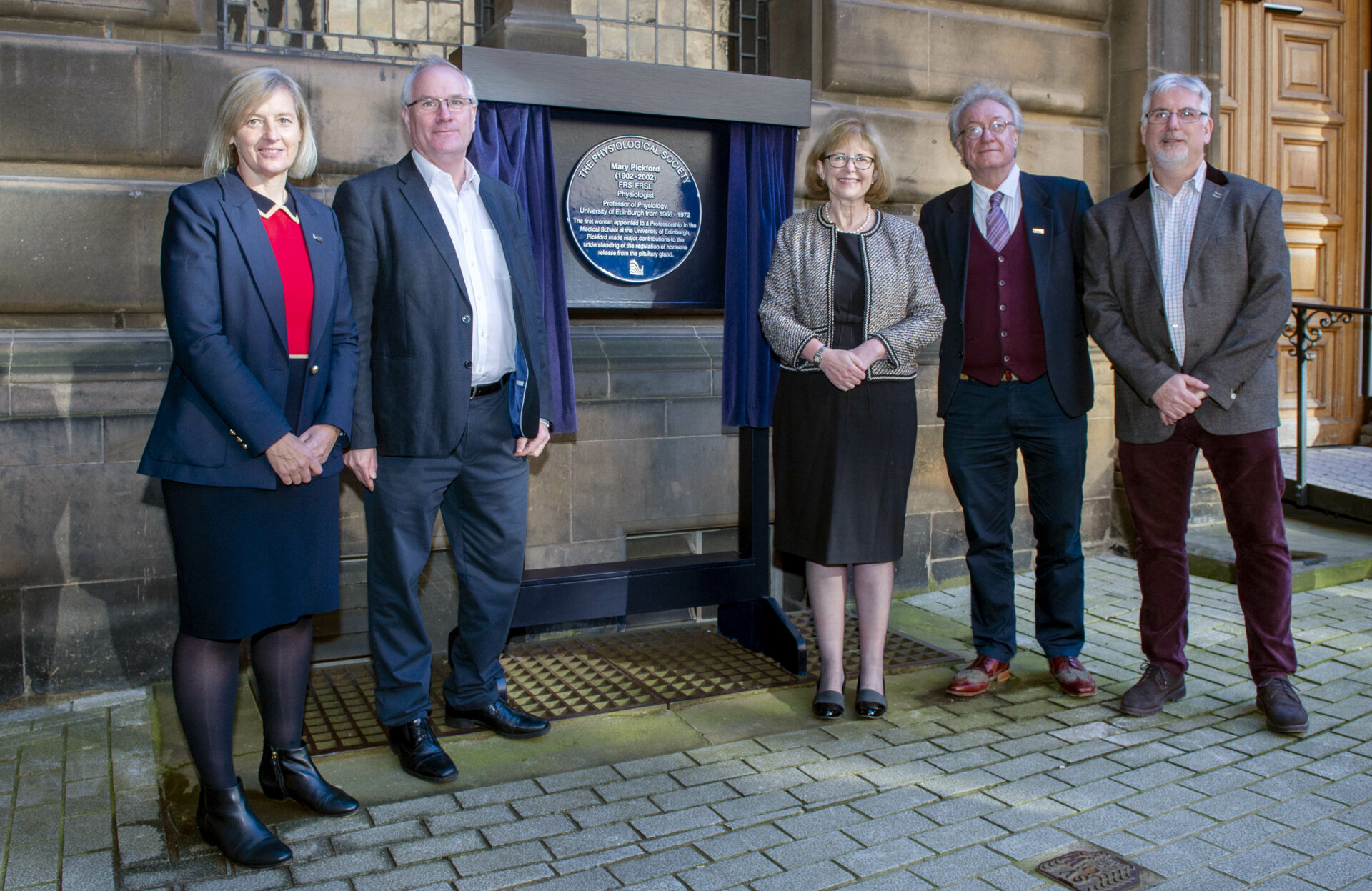
Information about Professor Mary Pickford
Professor Pickford started her career when there were few women doctors and considerable prejudice against women scientists; she went on to make her mark on medicine and physiological science.
Born in India, Pickford graduated in science from Bedford College, London, in 1924. While conducting pharmacological research part-time at UCL, with AJ Clarke and EB Verney, she trained in medicine and qualified in 1933.
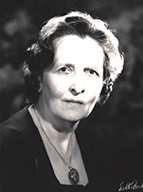
Mary Pickford, Photograph
After junior clinical jobs, she took a post as physiology lecturer at Edinburgh University, where she studied oxytocin and anti-diuretic hormone in dogs. She gained a DSc in 1951 (Edinburgh) and later was given an Honorary DSc by the Heriot-Watt University.
In 1954 she became a Fellow of the Royal Society of Edinburgh, in 1977 of the Royal College of Physicians of Edinburgh, and in 1966 of the Royal Society of London. In 1966, she was the first woman to hold a chair in the Edinburgh Medical Faculty. She published extensively and in 1972 was appointed Special Professor of Endocrinology at Nottingham University.
Mabel Purefoy FitzGerald - Oxford
Name of person: Mabel Purefoy FitzGerald
Location of plaque: University of Oxford
Date unveiled: 16 November 2021
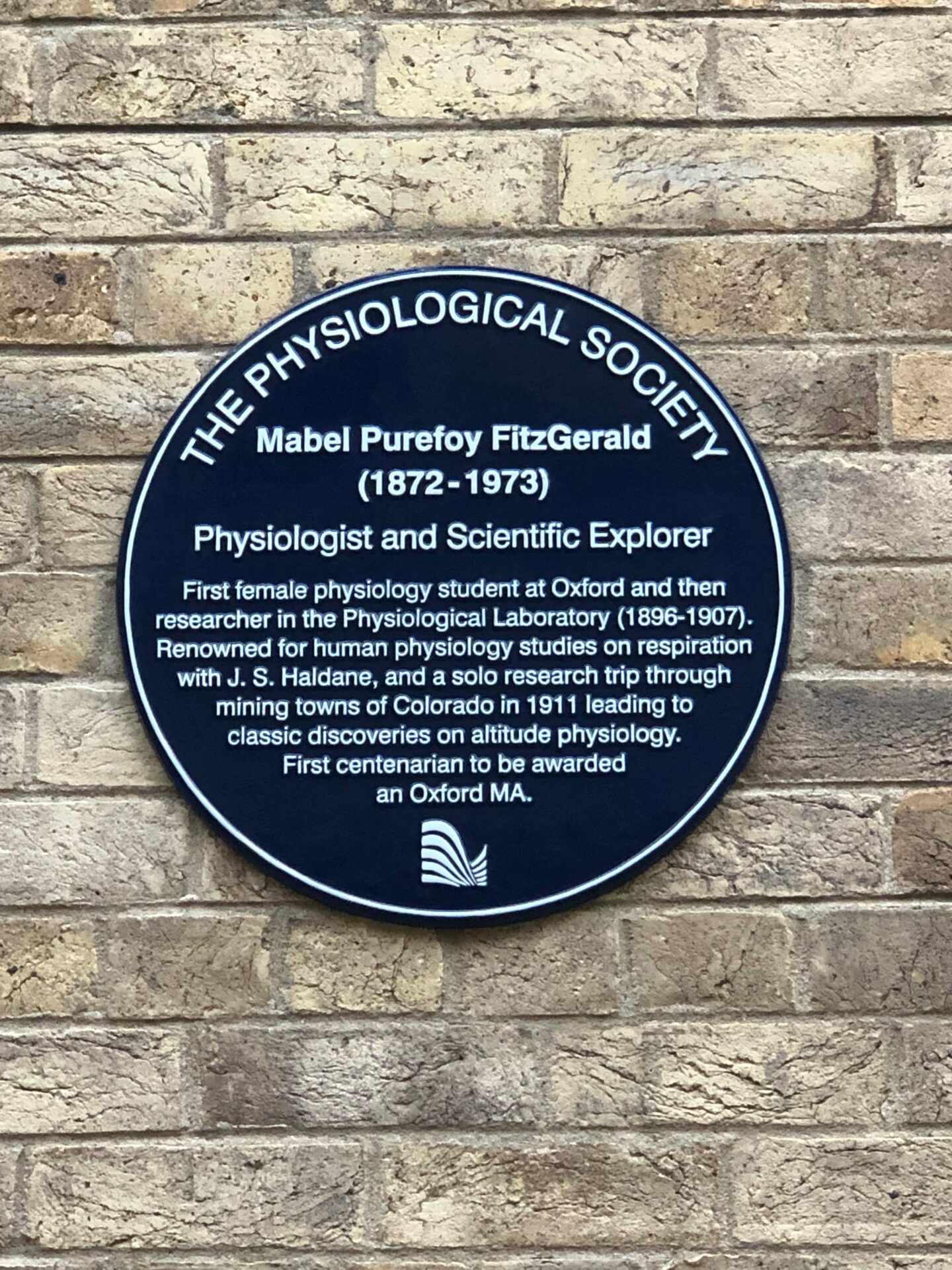
The plaque was unveiled by physiologist and NASA astronaut, Jessica Meir.
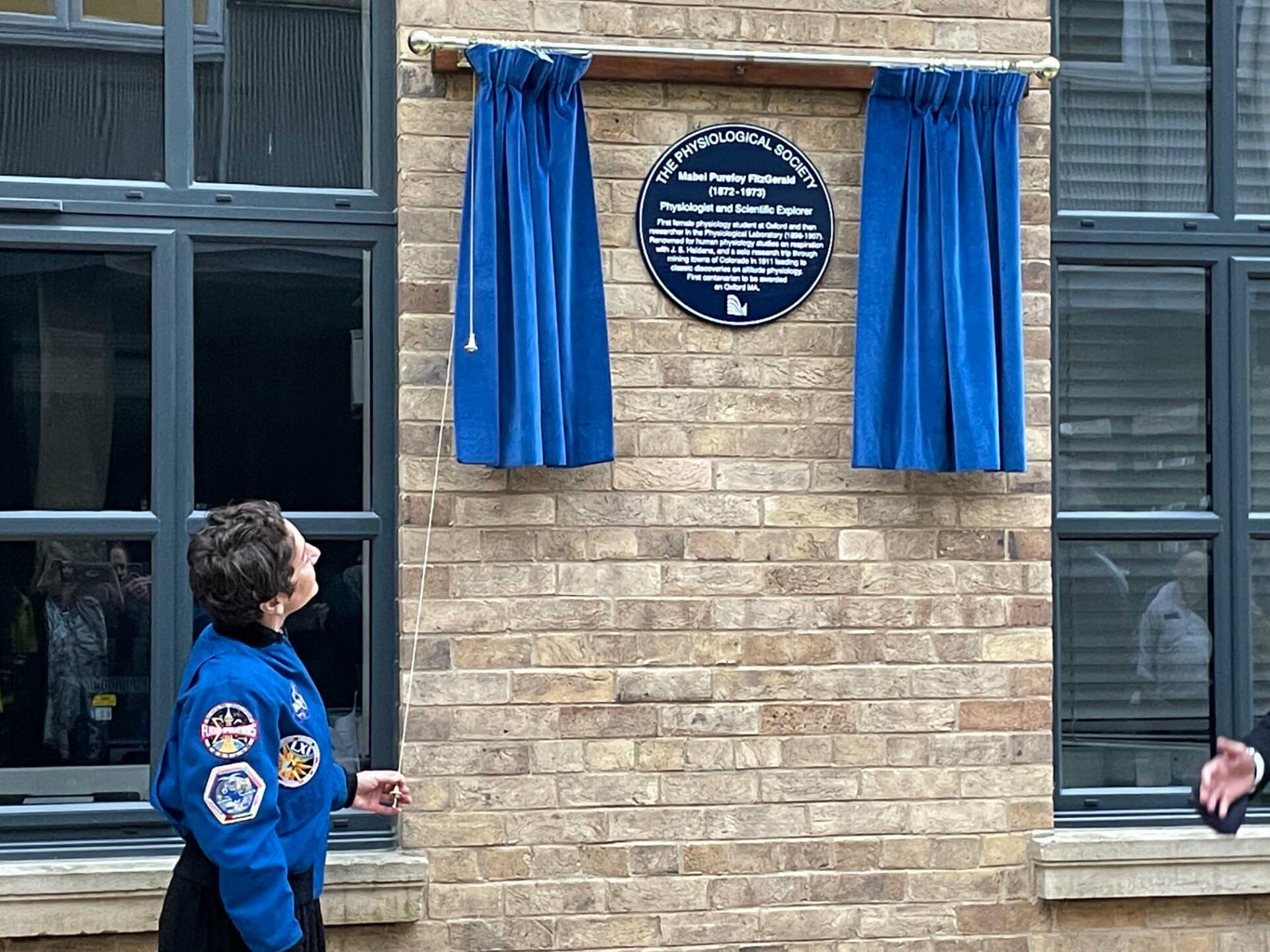
Information about Mabel Purefoy FitzGerald
Mabel Purefoy FitzGerald (1872-1973) was one of the first women admitted to scientific classes at Oxford. Her work in biomedical research led her from Oxford to Denmark, the United States, Canada and Scotland. She worked with Sir William Osler (1849-1919), JS Haldane (1860-1936), CS Sherrington (1857-1952) and other eminent scientists in a wide variety of fields including pathology, respiratory physiology, neurobiology, immunology and gastroenterology. She is most recognized for her contributions to our understanding of the control of breathing that arose from a solo research trip through the unruly mining towns of the Colorado Rockies.
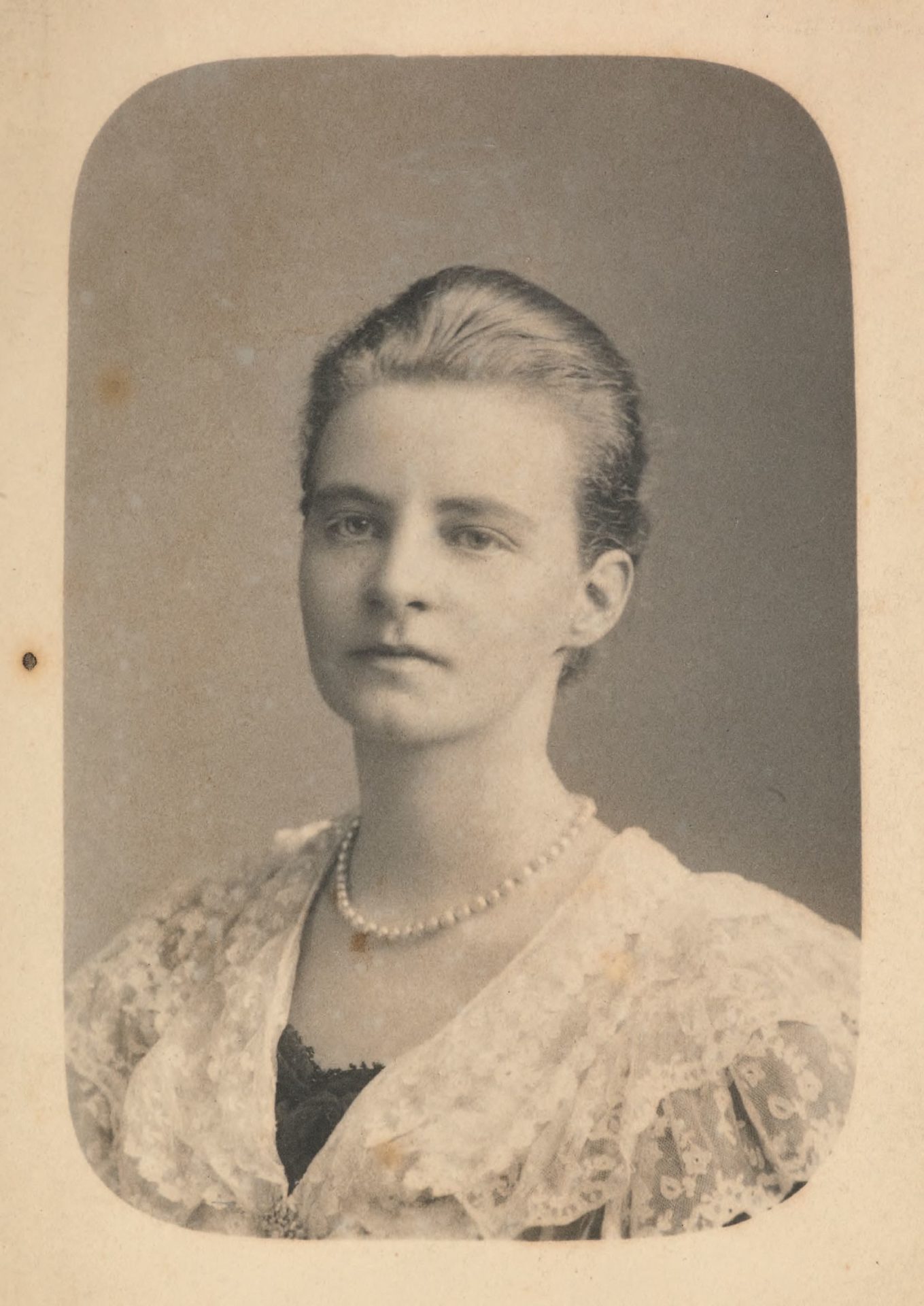
Mabel Purefoy Fitzgerald (Figure 1)
Additional reading:
Professor Winifred Cullis - London
Name of person: Professor Winifred Cullis
Location of plaque:8 Hunter Street, London (workplace of Winifred Cullis for almost her entire career)
Date unveiled: 18 November 2021

The plaque was unveiled by physiologist and NASA astronaut, Jessica Meir.
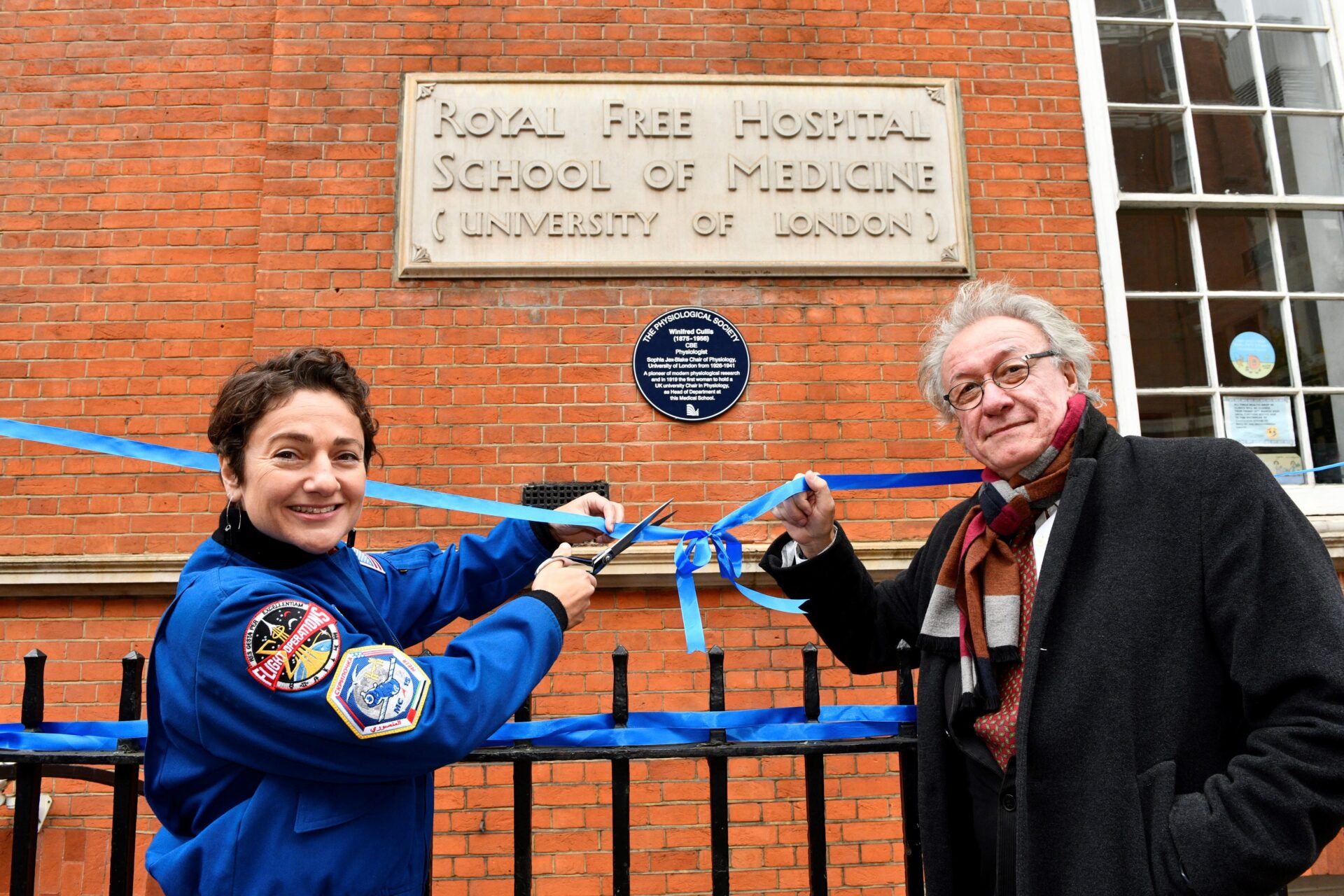
Information about Professor Winifred Cullis
Professor Cullis was an energetic advocate for the role of science in healthy living, the value of education in emancipating both sexes, and for international goodwill.
She was the first woman to serve on The Physiological Society’s Committee and the first to preside at a meeting of The Society in 1920. She was also the first woman Professor in a British medical school and the first UK university Chair in Physiology as Head of Department at the School of Medicine for Women.
Professor Cullis was also Sophia Jex-Blake Chair of Physiology at the University of London from 1926-1941.
Lord Edgar Douglas Adrian - Cambridge
Name of person: Lord Edgar Douglas Adrian
Location of plaque: Physiology Building, Department of Physiology, Downing Site, Cambridge, CB2 3EG (where Lord Adrian was the Professor of Physiology from 1937-1951).
Date unveiled: 9 December 2021
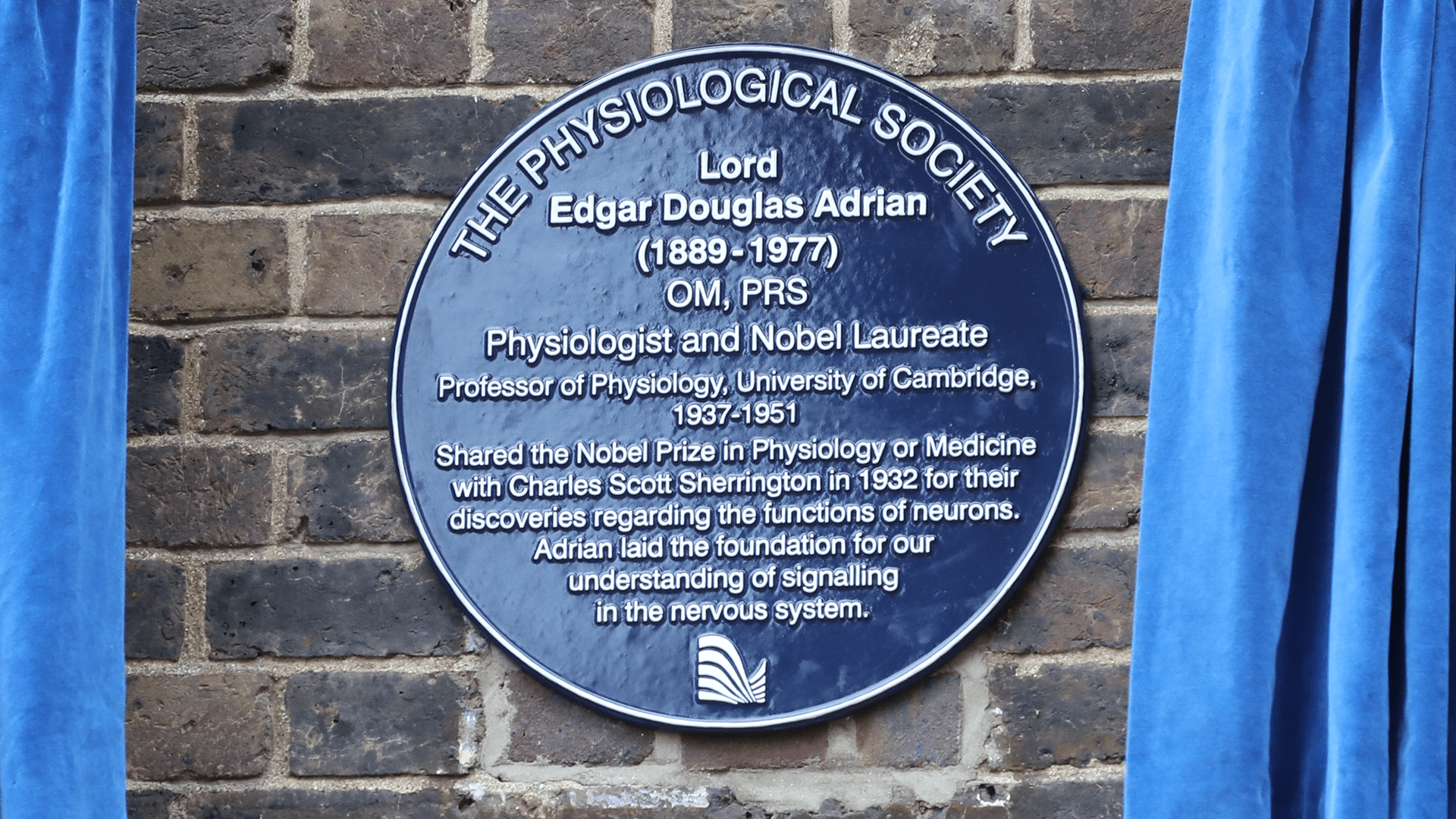
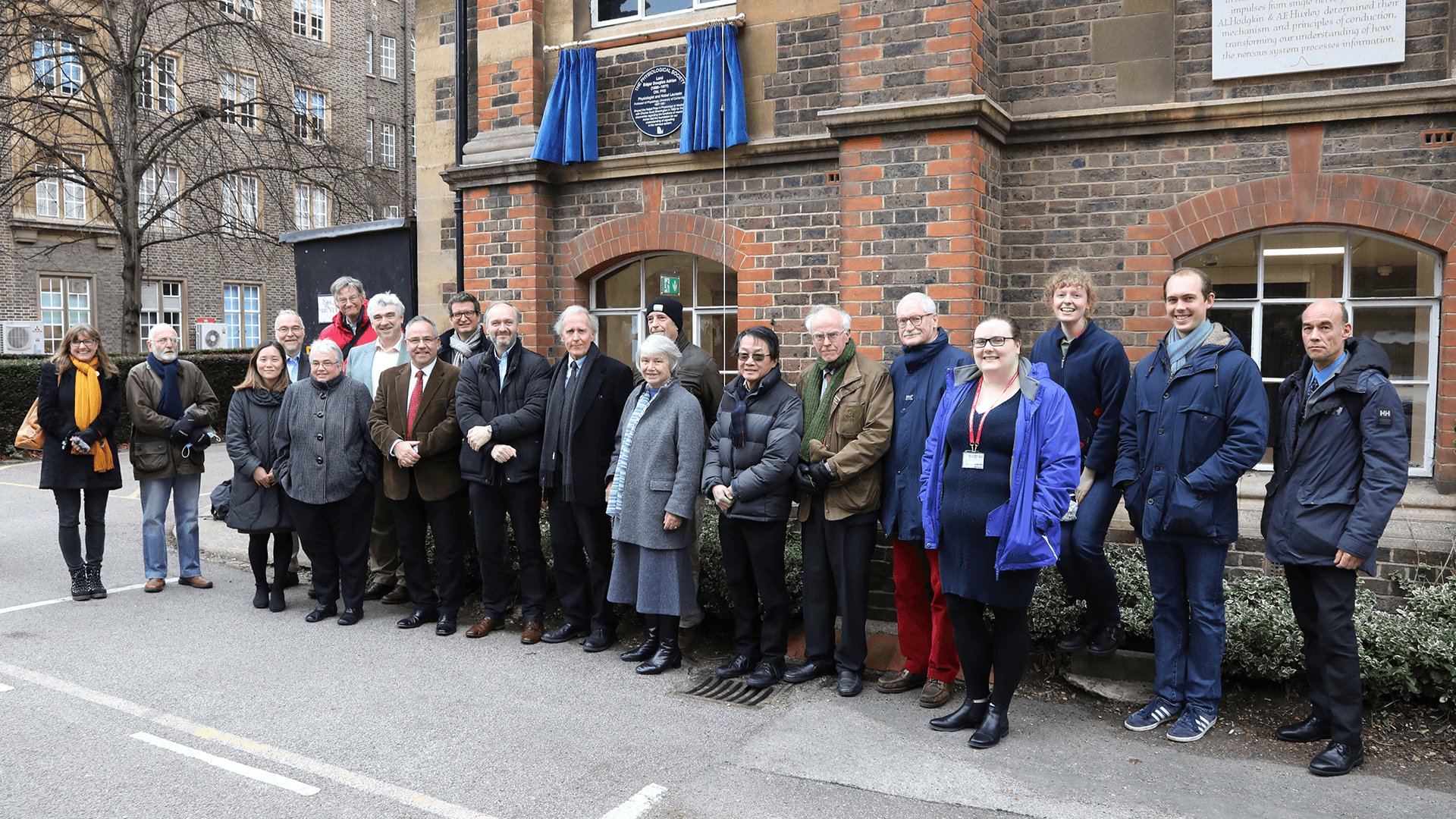
Information about Lord Edgar Douglas Adrian
Lord Edgar Adrian (30 November 1889 – 4 August 1977) was a physiologist and recipient of the 1932 Nobel Prize for Physiology, won jointly with Sir Charles Sherrington for work on the function of neurons. Among other titles he was: Professor of Physiology in the University of Cambridge 1937–1951; President of the Royal Society 1950–1955; Master of Trinity College, Cambridge, 1951–1965; president of the Royal Society of Medicine 1960–1962; Chancellor of the University of Cambridge 1967–1975; Chancellor of the University of Leicester 1957–1971. In 1942 he was awarded membership to the Order of Merit and in 1955 was created Baron Adrian, of Cambridge in the County of Cambridge. He died in Cambridge and was given the honour of being buried in Trinity College, Cambridge.
Professor Sydney Ringer - London
Name of person: Professor Sydney Ringer
Location of plaque: Medical Sciences and Anatomy building, Gower Street, University College London, UK (where he worked from 1860 to 1900).
Date unveiled: 24 March 2022
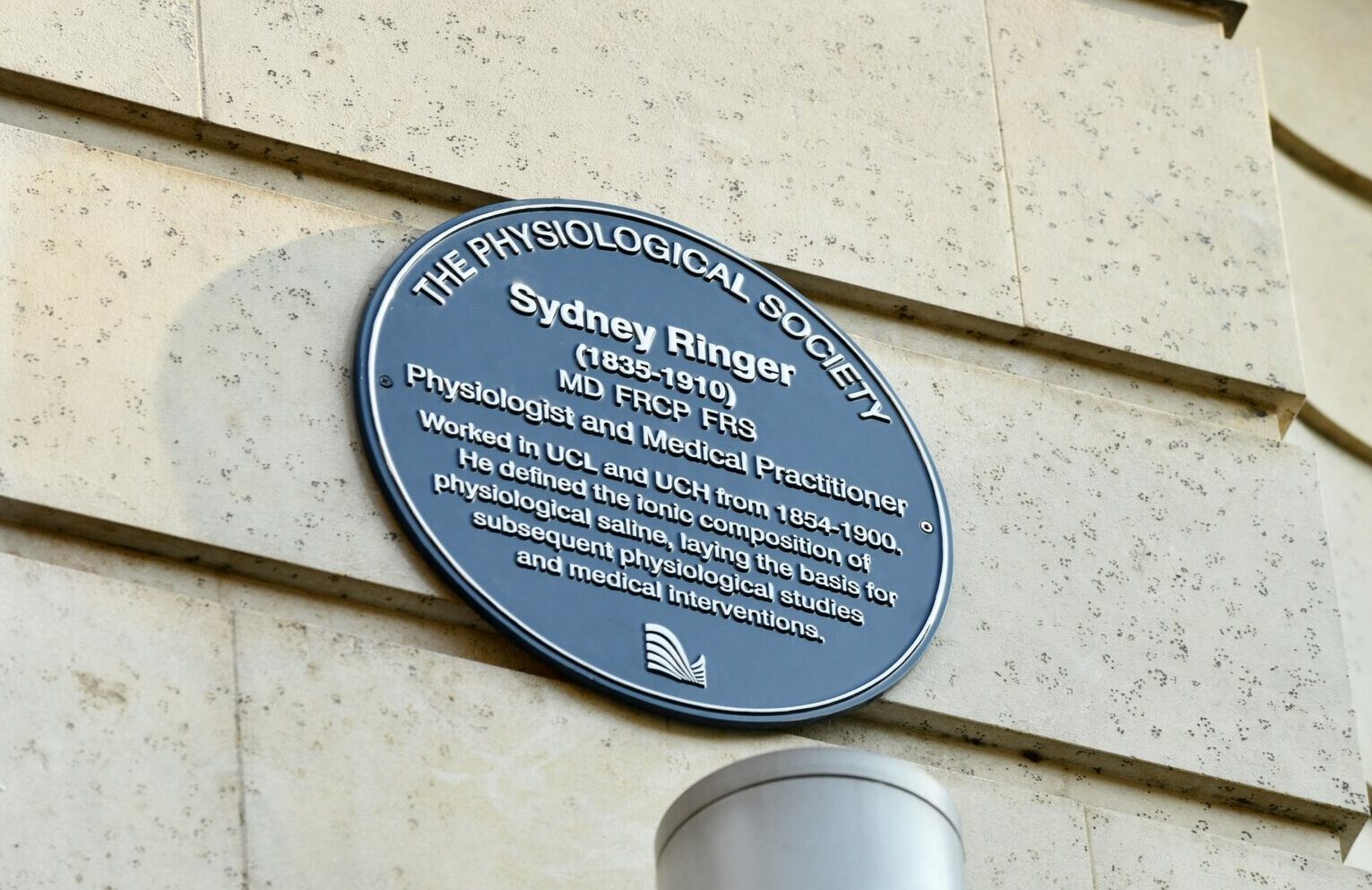

The plaque was unveiled by Professor Andrew Pomiankowski, Director of Division of Biosciences at University College London, UK.
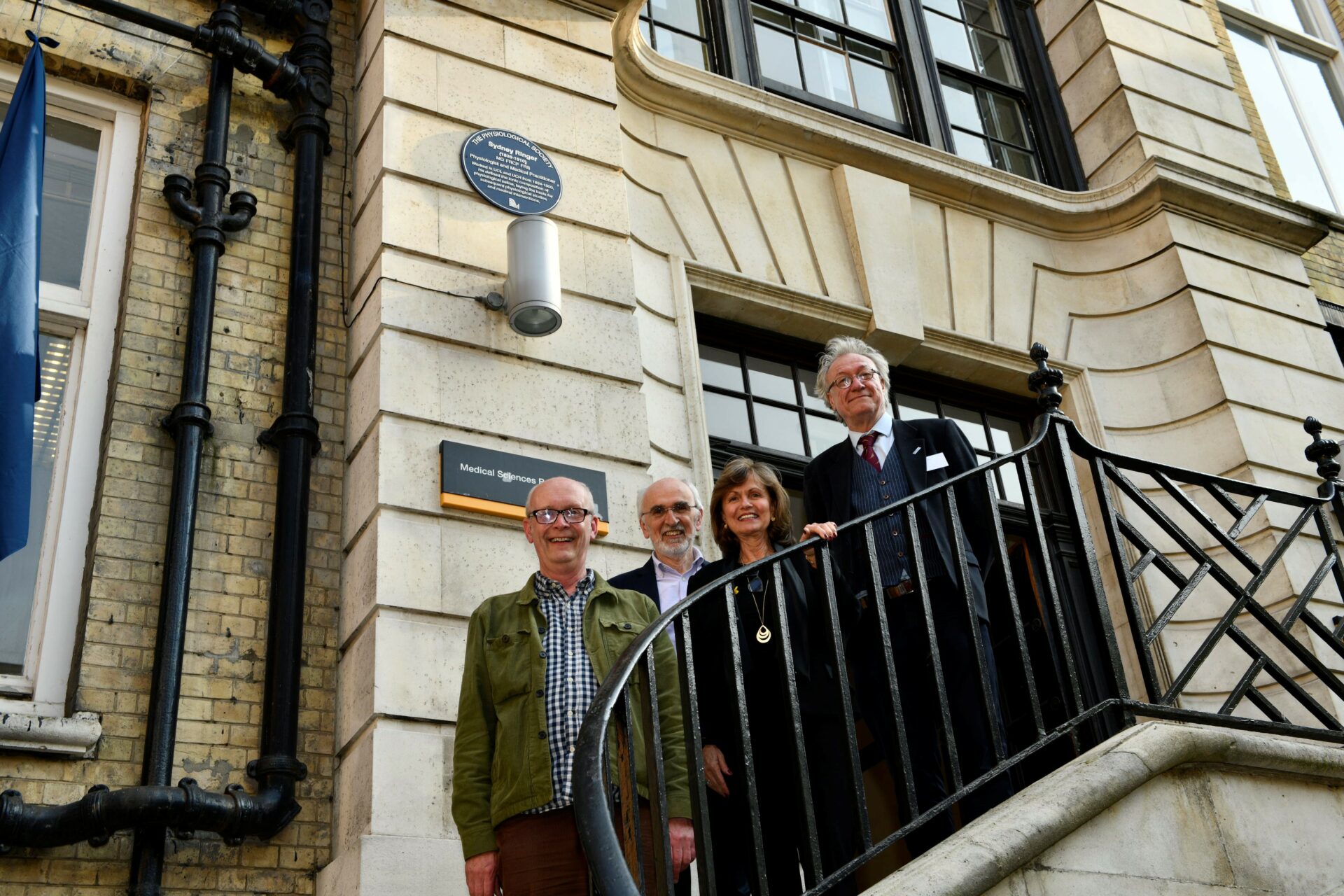
Information about Professor Sydney Ringer
Professor Sydney Ringer was a British clinician, whose research still underlies modern physiology and pharmacology. Ringer worked at University College London and its hospital from 1860 to 1900. During this time, he was also Assistant Physician at Great Ormond Street Hospital for Children in London. In 1883, Ringer invented the composition for a saline solution (a mixture of salt and water) that could maintain the beat of the frog’s heart. This saline recipe is referred to as ‘Ringer’s solution’ and it is now commonly used in the intravenous fluid drips in hospital wards and surgical theatres providing life-saving fluid replacement for patients. Ringer was one of the earliest members of The Physiological Society, joining in 1884.
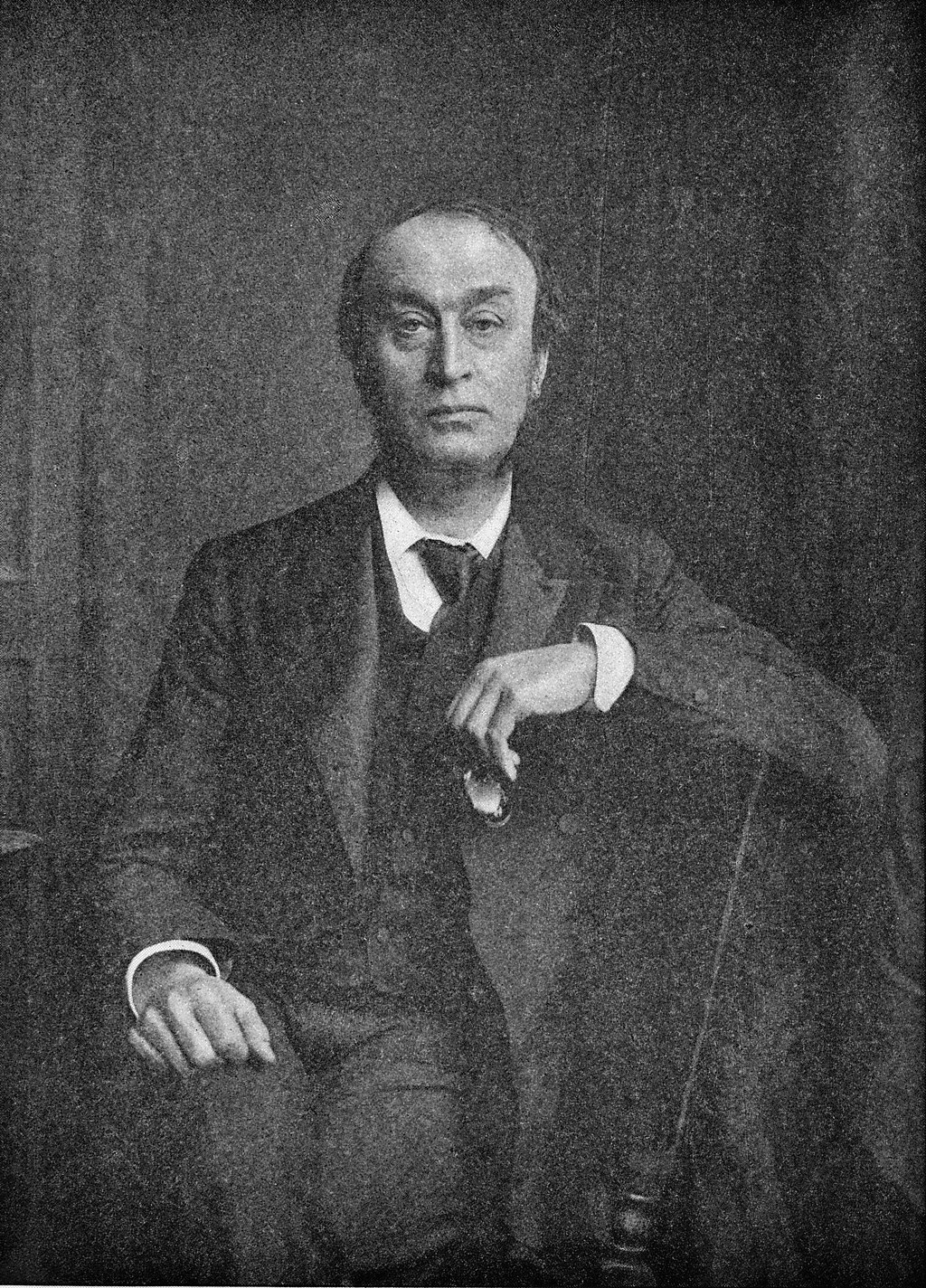
Sir Edward Albert Sharpey-Schafer - Edinburgh
Name of person: Sir Edward Albert Sharpey-Schafer
Location of plaque: Old Medical School Quad at the University of Edinburgh, UK (where Sharpey-Schafer was appointed Chair of Physiology from 1899 until his retirement.)
Date unveiled: 10 May 2022

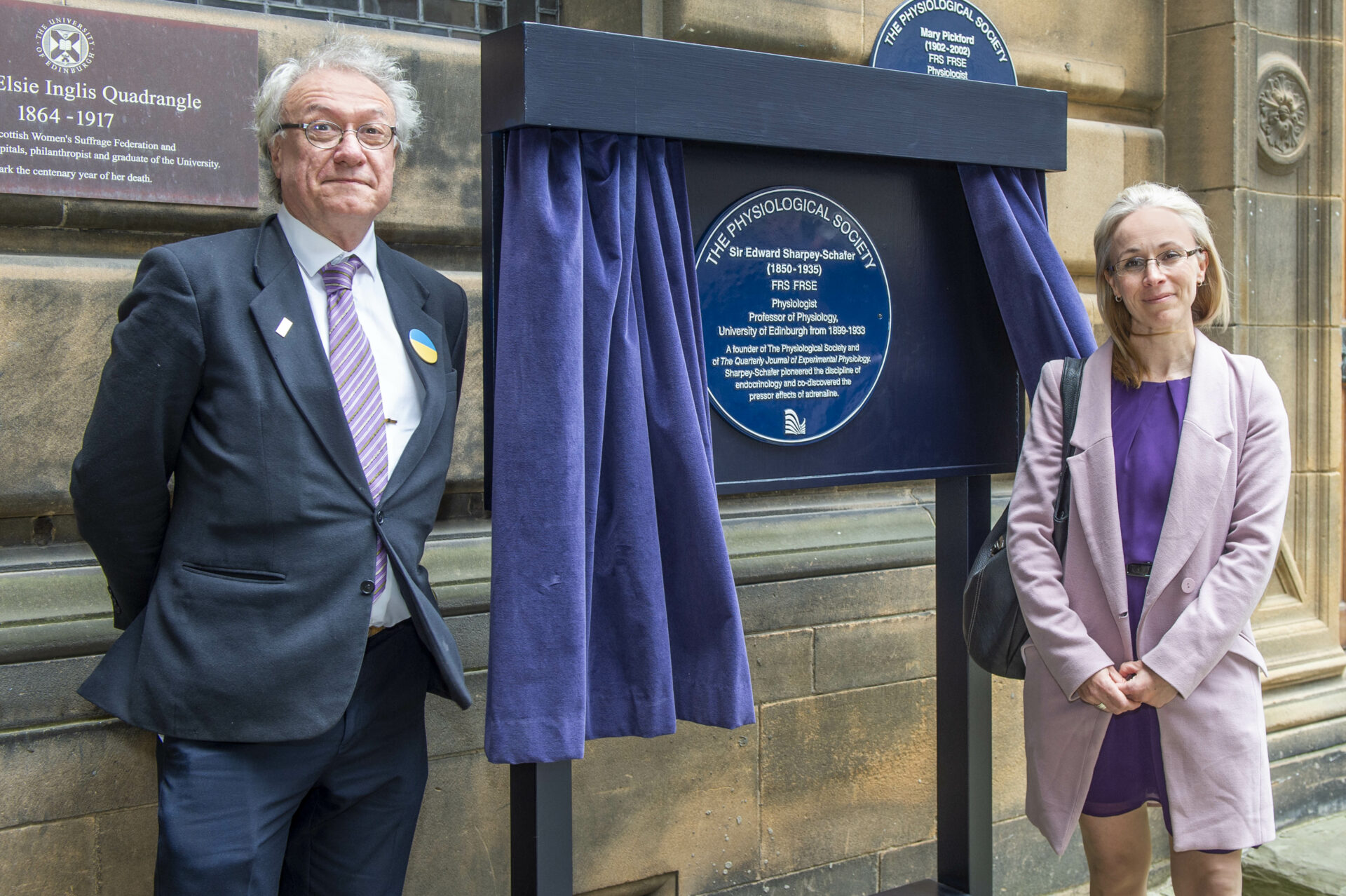
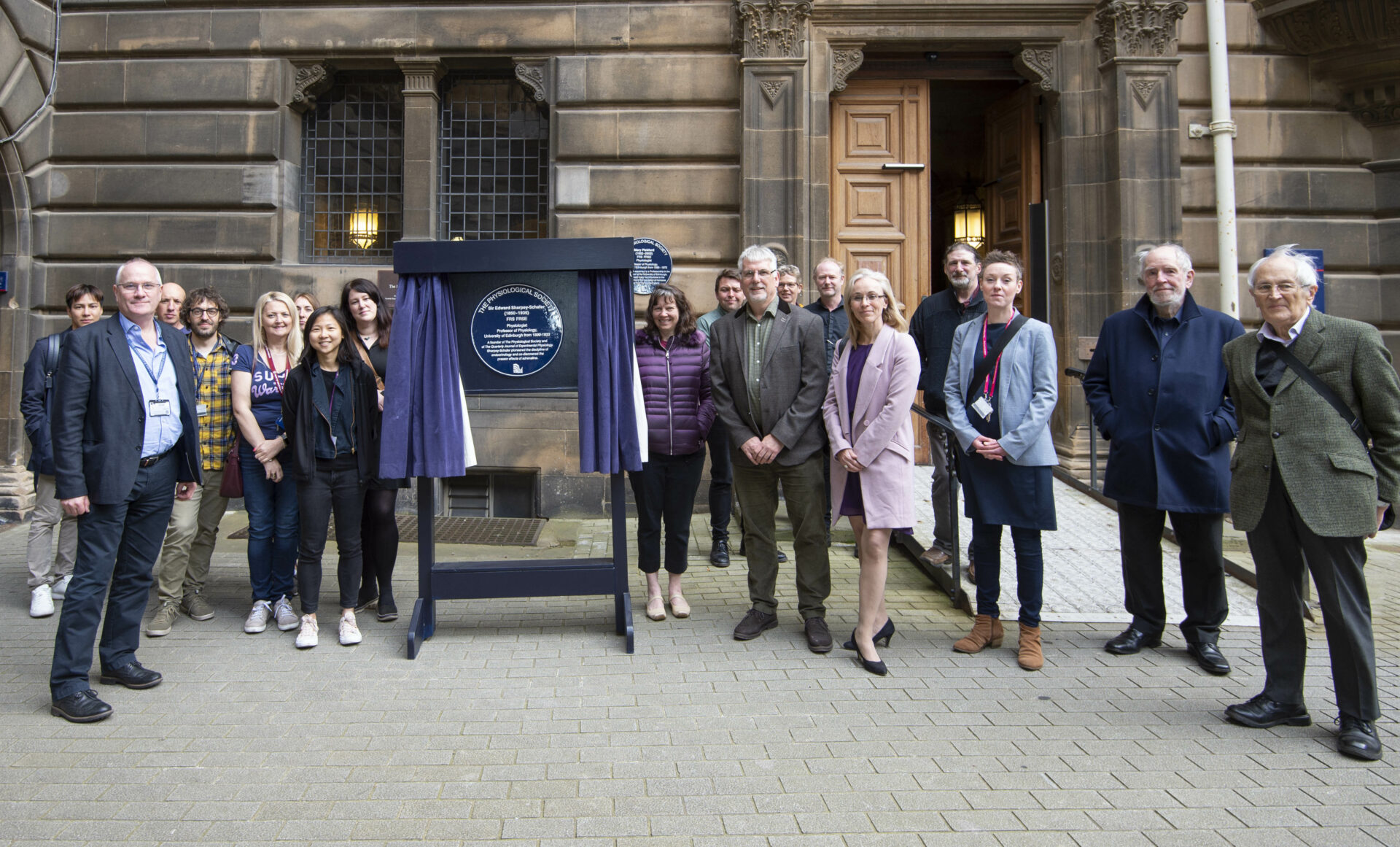
Information about Sir Edward Albert Sharpey-Schafer:
Sir Edward Albert Sharpey-Schafer (1850 –1935) was an English physiologist and Fellow of the Royal Society. Born Edward Schäfer, he studied under the physiologist William Sharpey and became the first Sharpey Scholar in 1873 at University College London (UCL). In 1874 he was appointed Assistant Professor of Practical Physiology at UCL where he went on to become Jodrell Professor. He was elected a Fellow of the Royal Society in 1878 at the age of just 28. Schäfer was appointed Chair of Physiology at the University of Edinburgh in 1899 where he would stay until his retirement. He was one of the nineteen founder members of the Physiological Society in 1876 and he also founded and edited [the Quarterly Journal of] Experimental Physiology from 1908 until 1933. Schäfer was knighted in 1913. He is renowned for his invention of the prone-pressure method or Schäfer method of artificial respiration. He was very active as a facilitator, mentor, coordinator, teacher and organiser through much of his career. He had started as a histologist and always emphasised the importance of structural knowledge. He was the co-discoverer (in 1894, with George Oliver) of adrenaline (as in the adrenal-derived, circulating hormone) and he coined the term ‘endocrine’ as the generic term for such secretions.
After the death of his eldest son, John Sharpey Schafer, and in memory of his late professor William Sharpey, he changed his surname to Sharpey-Schafer in 1918.
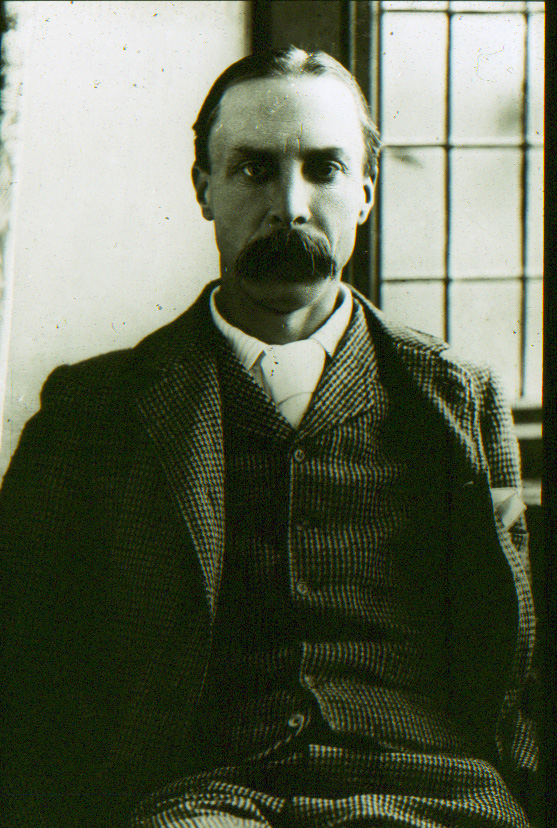
Image in the public domain. Source: NobelPrize.org
Professor Henry Barcroft - Belfast
Name of person: Professor Henry Barcroft
Location of plaque: Lanyon Building Quadrangle at Queen’s University Belfast, UK (where Barcroft was appointed the Dunville Chair of Physiology).
Date unveiled: 22 June 2022
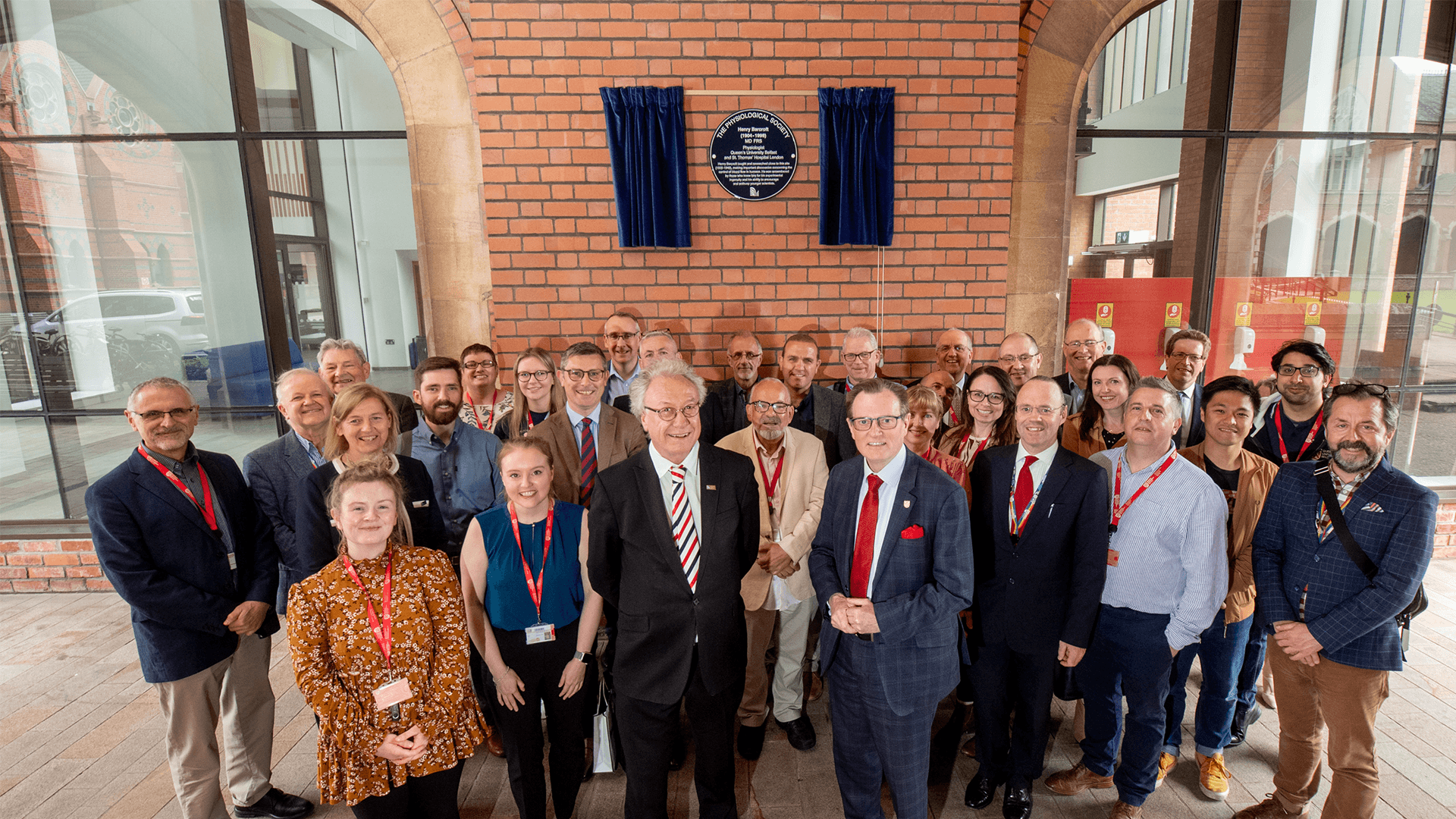
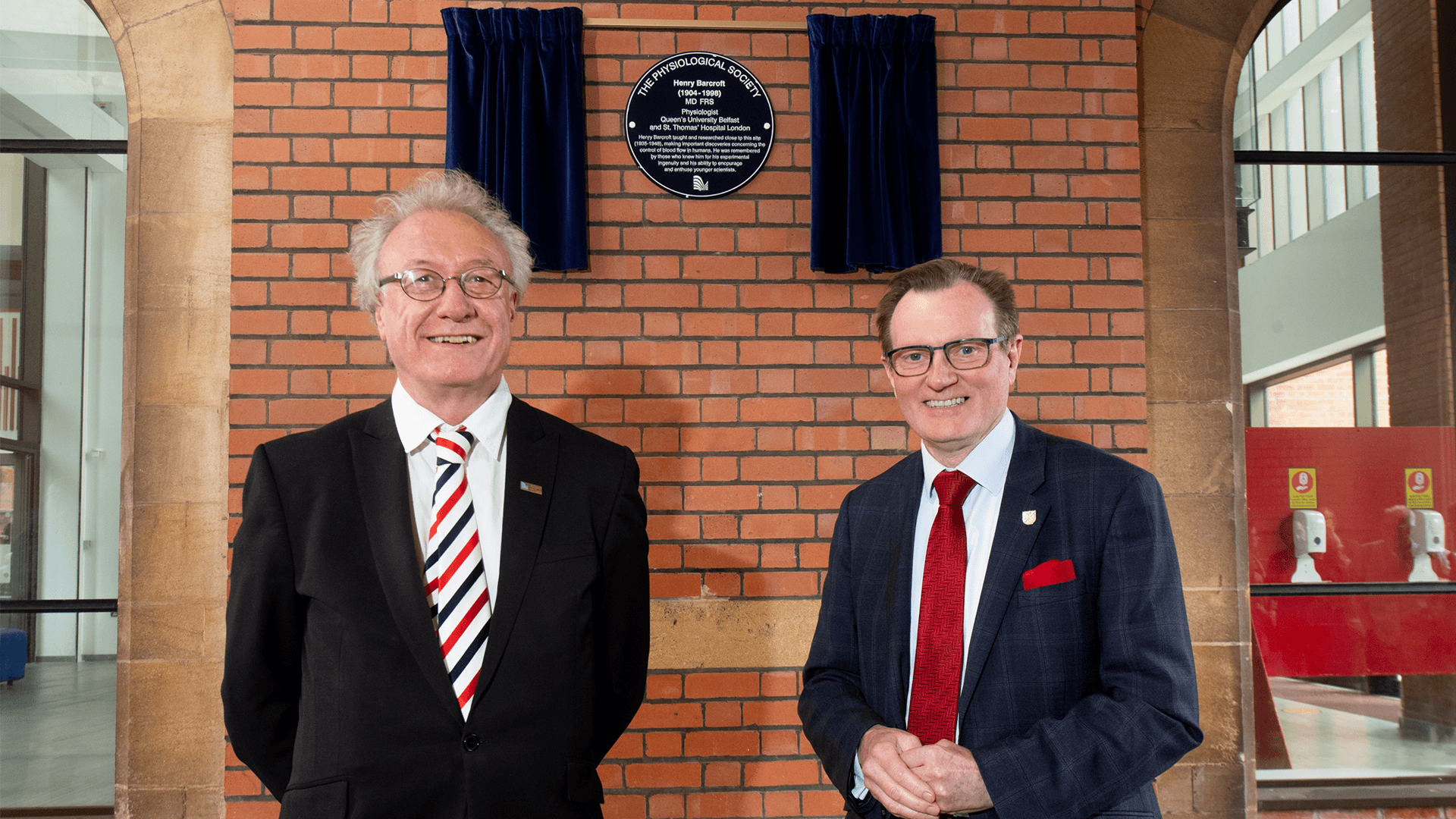
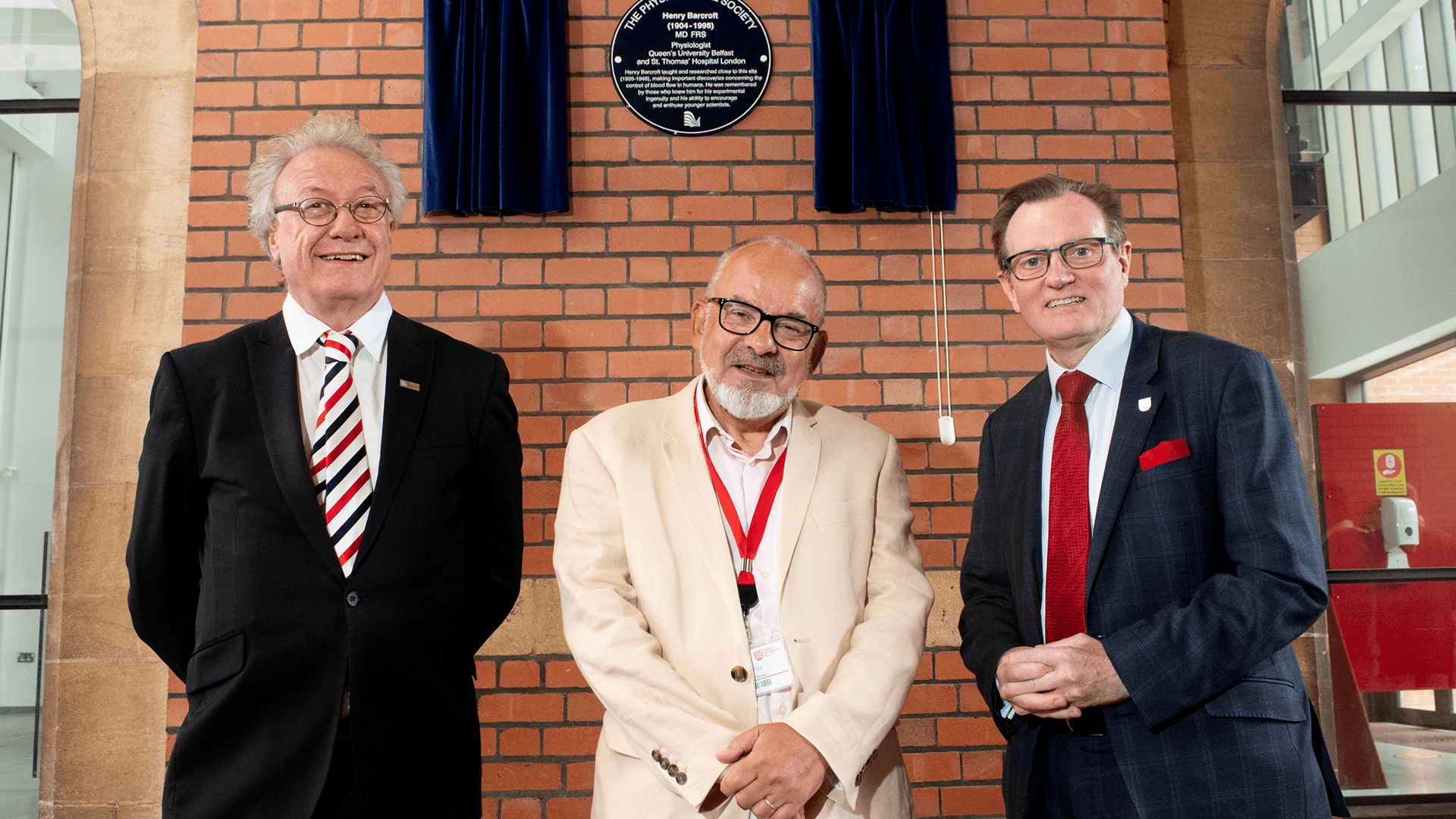
Information about Professor Henry Barcroft:
Barcroft (1904-1988) is renowned for his work on the circulatory system. His meticulous research on blood flow determined how nerves and hormones control blood flow in the limbs.
Barcroft developed a new form of the stromuhr to measure the rate of blood flow at frequent intervals. An upgrade on the devices available at the time which could only take an average reading over a long period of time. Barcroft used this to study the regulation of blood flow in the limbs and to characterise fluctuations.
He used himself, healthy volunteers and willing patients as participants to better understand human physiology. He worked with Otto Edholm to devise a non-invasive method, known as “venous occlusion plethysmography”, to measure blood flow in the limbs. The work determined the active roles of the nerve fibres in constricting and dilating the blood vessels, which was vital to the study and treatment of high blood pressure.
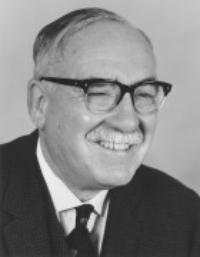
Professor Gerald Francis Yeo - Dublin
Name of person: Gerald Francis Yeo
Location of plaque: Tercentenary Hall at Trinity College Dublin, Ireland, where Yeo first graduated in Natural Sciences in 1866.
Date unveiled: June 23, 2022
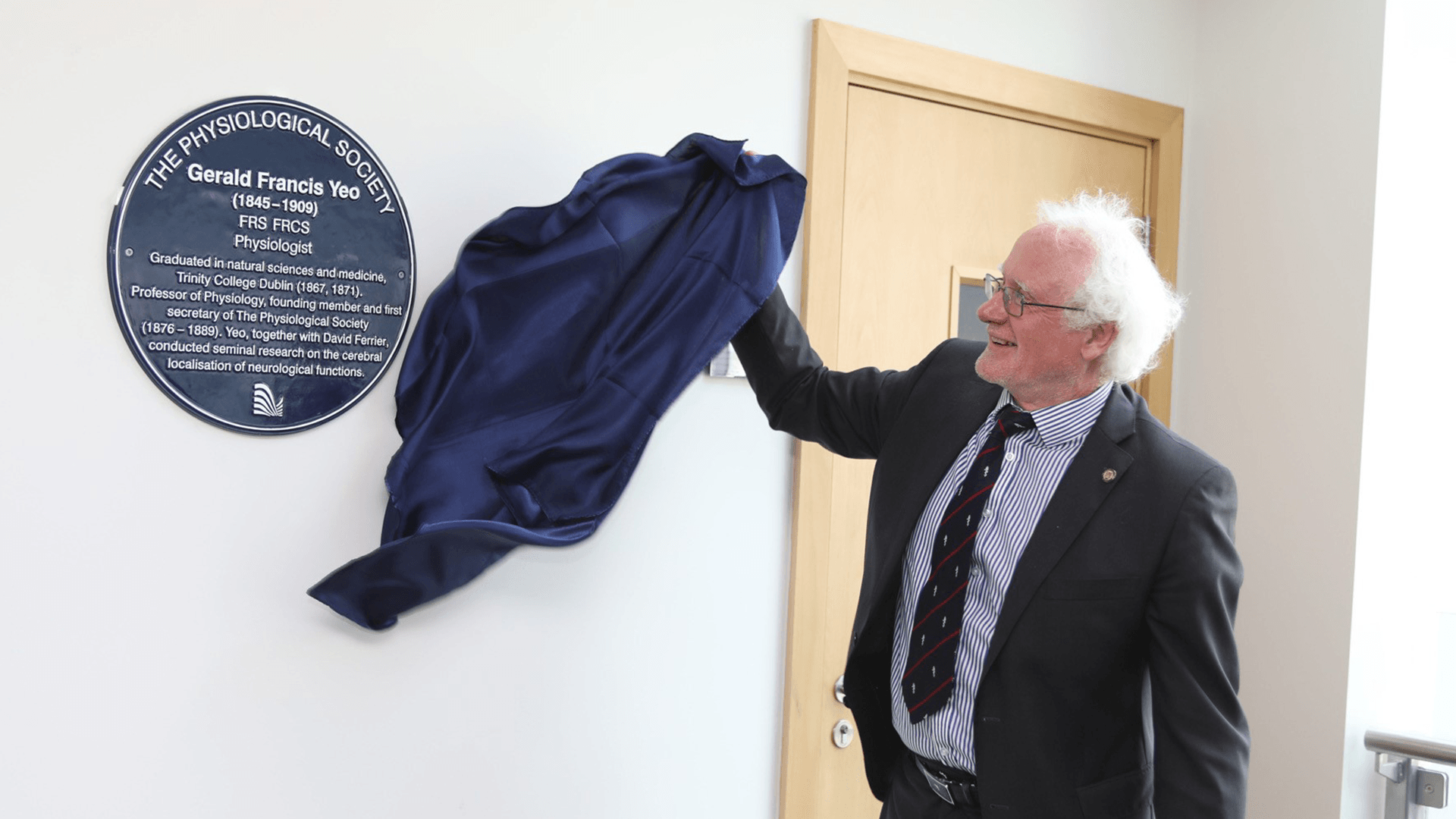



Information about Gerald Francies Yeo:
Yeo was one of 19 physiologists who gathered at the house of John Burdon on March 1876 to form The Physiological Society for ‘promoting the advancement of physiology and facilitating the intercourse between physiologists’. Yeo was the Secretary of The Society until 1889 and campaigned for the value of in vivo research in response to Victorian anti-vivisection campaigns.
Yeo graduated in Natural Sciences in 1866 from Trinity College Dublin, Ireland.
He spent a few years studying in Europe and went onto complete his medical degree at University of Dublin, Ireland, and the Royal College of Surgeons of Ireland. It was then that Yeo returned to Trinity College, Dublin acting as Demonstrator of Anatomy.
In 1868 he gained the gold medal of the Dublin Pathological Society for an essay on renal disease. He went onto teach physiology in the Carmichael School of Medicine in Dublin, Ireland, from 1872-1874. In 1875, he was appointed Professor of Physiology at King’s College London, UK and a couple of years later became Assistant Surgeon at King’s College Hospital.
While at King’s College London, Yeo worked with Sir David Ferrier, a Professor of Neuropathology, and together they helped advance brain surgery by studying cerebral localisation in monkeys. The experiments were performed using the antiseptic measures developed by Joseph Lister.
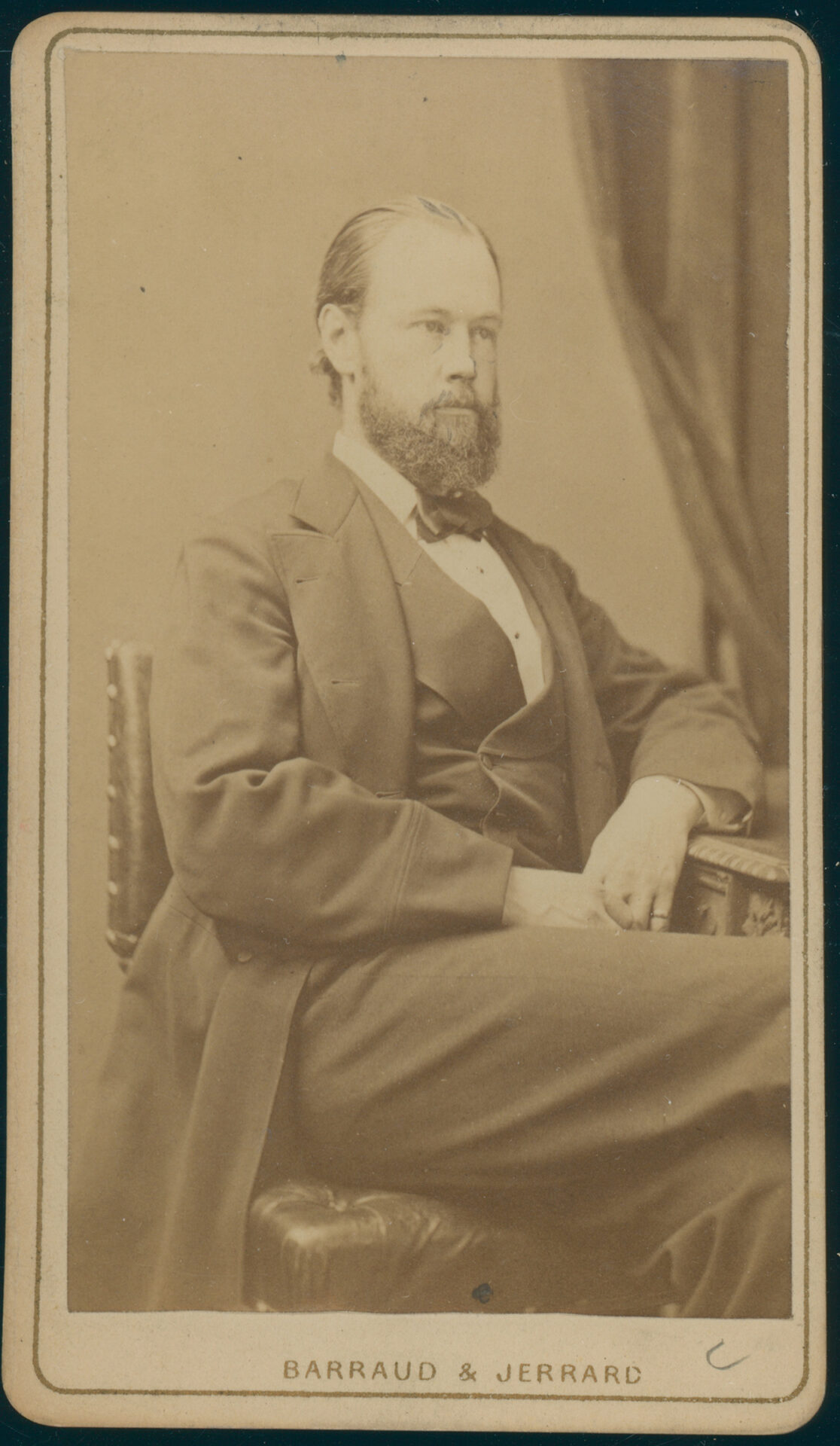
Photograph: Carte-de-visite of Gerald Francis Yeo by Barraud & Jerrard. In the New York Academy of Medicine, Carte de Visite Collection.
Dr Florence Buchanan - Oxford
Name of person: Dr Florence Buchanan
Location of plaque: The Department of Physiology, Anatomy and Genetics at University of Oxford, UK where Buchanan worked as a research assistant with John Burdon-Sanderson on the electrical responses of muscle.
Date unveiled: 1 July 2022

Professor Dame Frances Ashcroft unveiled the blue plaque dedicated to Dr Florence Buchanan.



Information about Dr Florence Buchanan:
Dr Florence Buchanan read Zoology at University College London, graduating in 1890. Florence Buchanan is now widely renowned for her discoveries on the transmission of reflex impulses in mammals, birds and reptiles, and the neural control of the heartbeat during exercise
Dr Buchanan was the first woman to attend a meeting of The Physiological Society in 1896. Buchanan worked as a research assistant with John Burdon-Sanderson on the electrical responses of muscle at the University of Oxford.
When Burdon-Sanderson left University of Oxford in 1904, Dr Buchanan moved to the University Museum of Natural History, where she set up her own lab funded by grants from The Royal Society. She was especially interested in the frequency of the heart rate, and how it varied in different species, in hibernating animals and during exercise. Among her many contributions, she provided data for August Krogh, who wrote “Miss Buchanan has shown us the very great kindness to take some electrocardiograms on subjects starting work on a stationary tricycle”. One of her subjects was the famous Oxford respiratory physiologist CG Douglas, who apparently was ‘not at all heated’ by the exercise. Unfortunately, despite providing data, Dr Buchanan does not appear as an author on the paper, something that would certainly happen now.
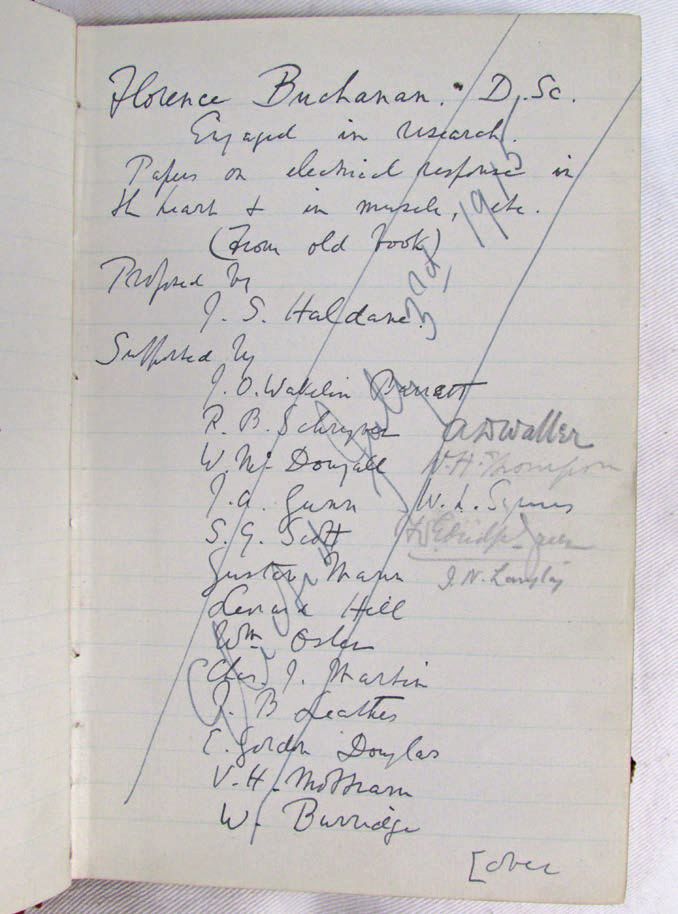
Image shows the entry for Florence Buchanan in The Society’s Candidates’ Book
In 1912, after she had been going to meetings of The Society for 16 years, John Scott Haldane proposed her for membership, making her the first woman proposed to become a member of The Physiological Society. She received 50 signatures of support from renowned scientists. Despite some significant opposition, a membership ballot resulted in overwhelming support for women and in July 1915 the first 6 women were admitted, Dr Buchanan being one of them. By then, she had given at least 10 communications to The Society, published 2 papers in The Journal of Physiology and 3 in what is now called Experimental Physiology.
Professor Sir Michael Foster - Cambridge
Name of person: Sir Michael Foster
Location of plaque: Physiology Building at the University of Cambridge where he was Praelector and Chair of Physiology.
Date unveiled: 6 July 2022
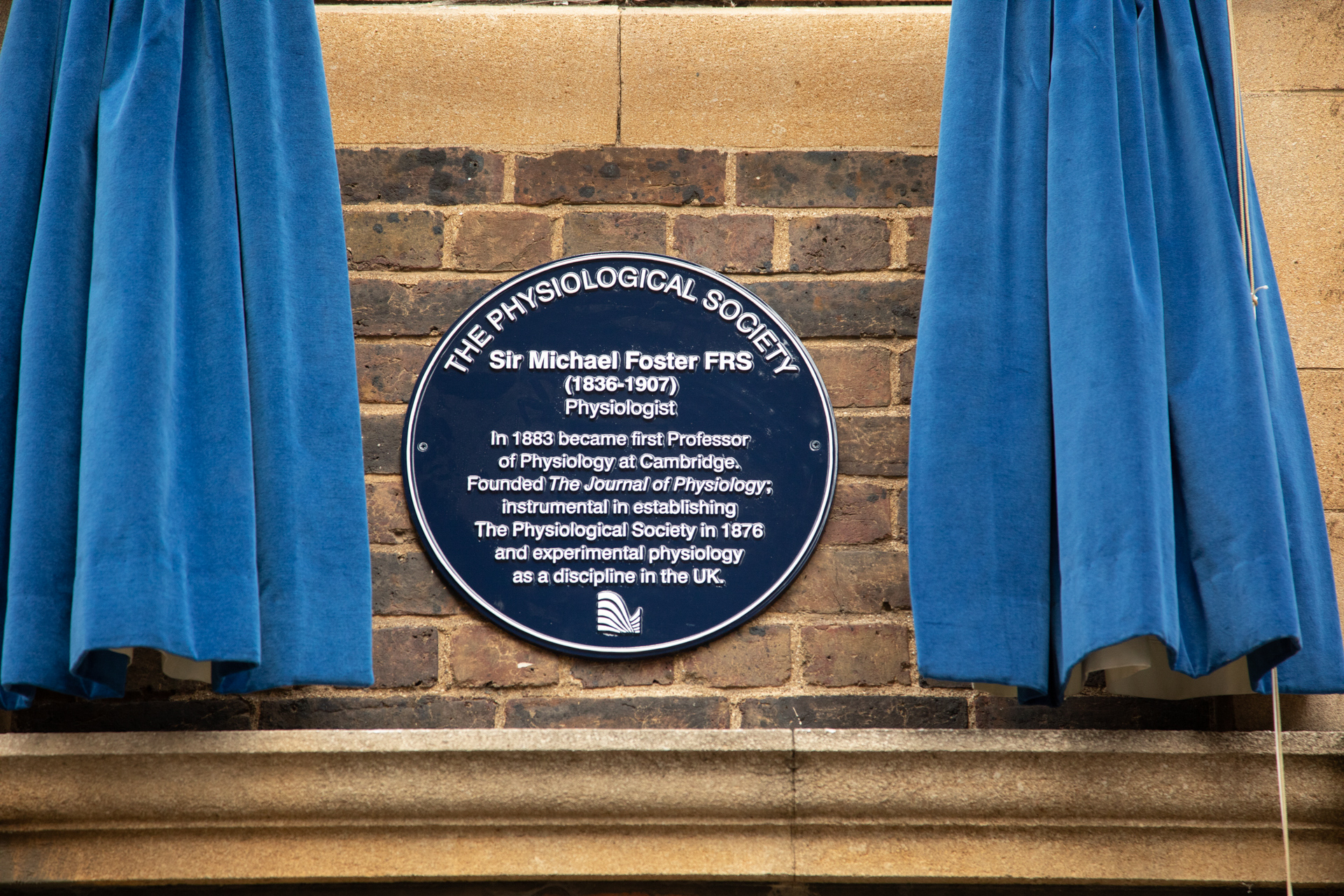
The plaque was unveiled by Professor Ole Paulsen, Chair of Physiology in the Department of Physiology, Development and Neuroscience at the University of Cambridge, UK
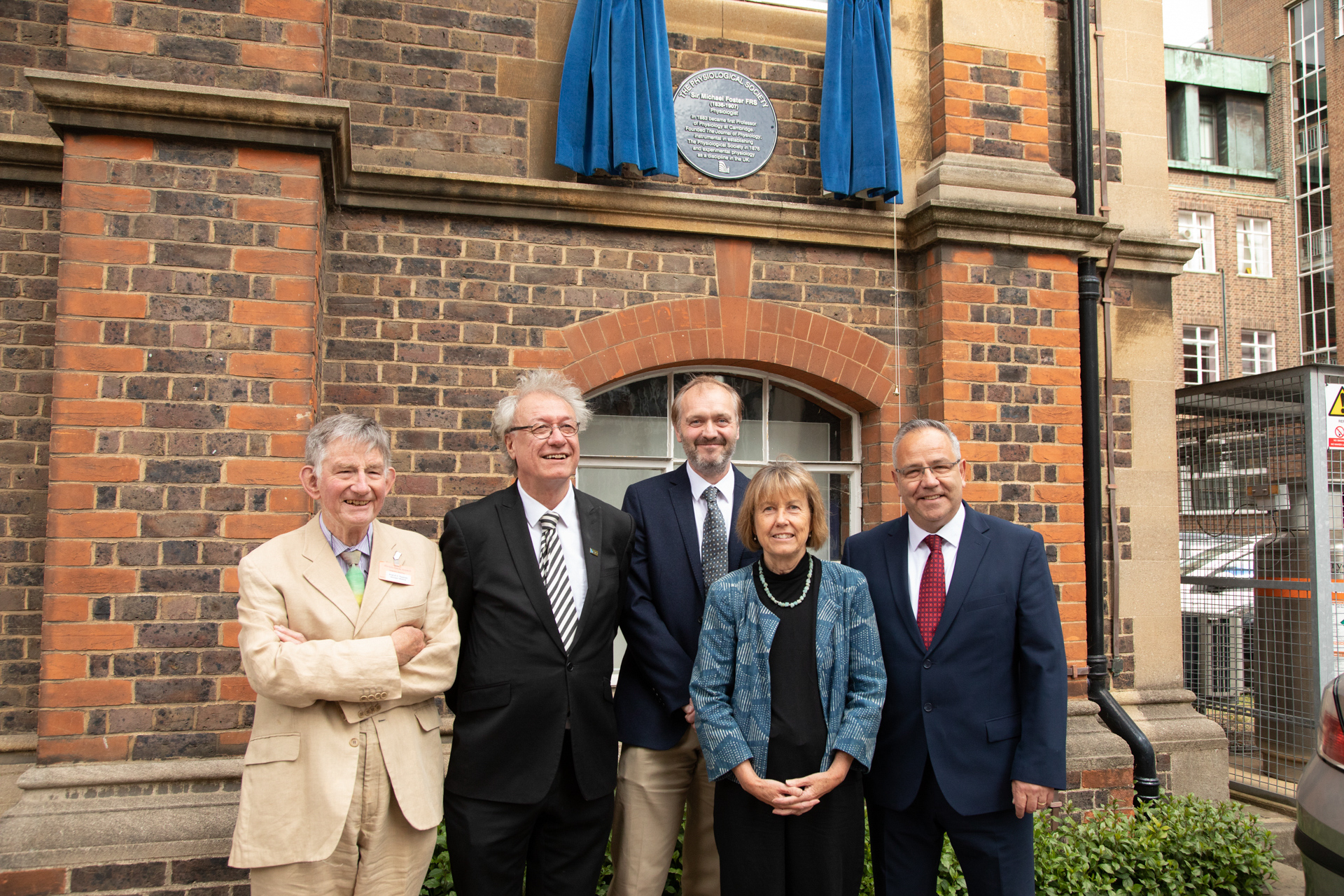
Pictured L-R: Professor Roger Thomas, Professor David Paterson, Professor Bill Colledge, Dr Sue Jones and Professor Dino Giussani.
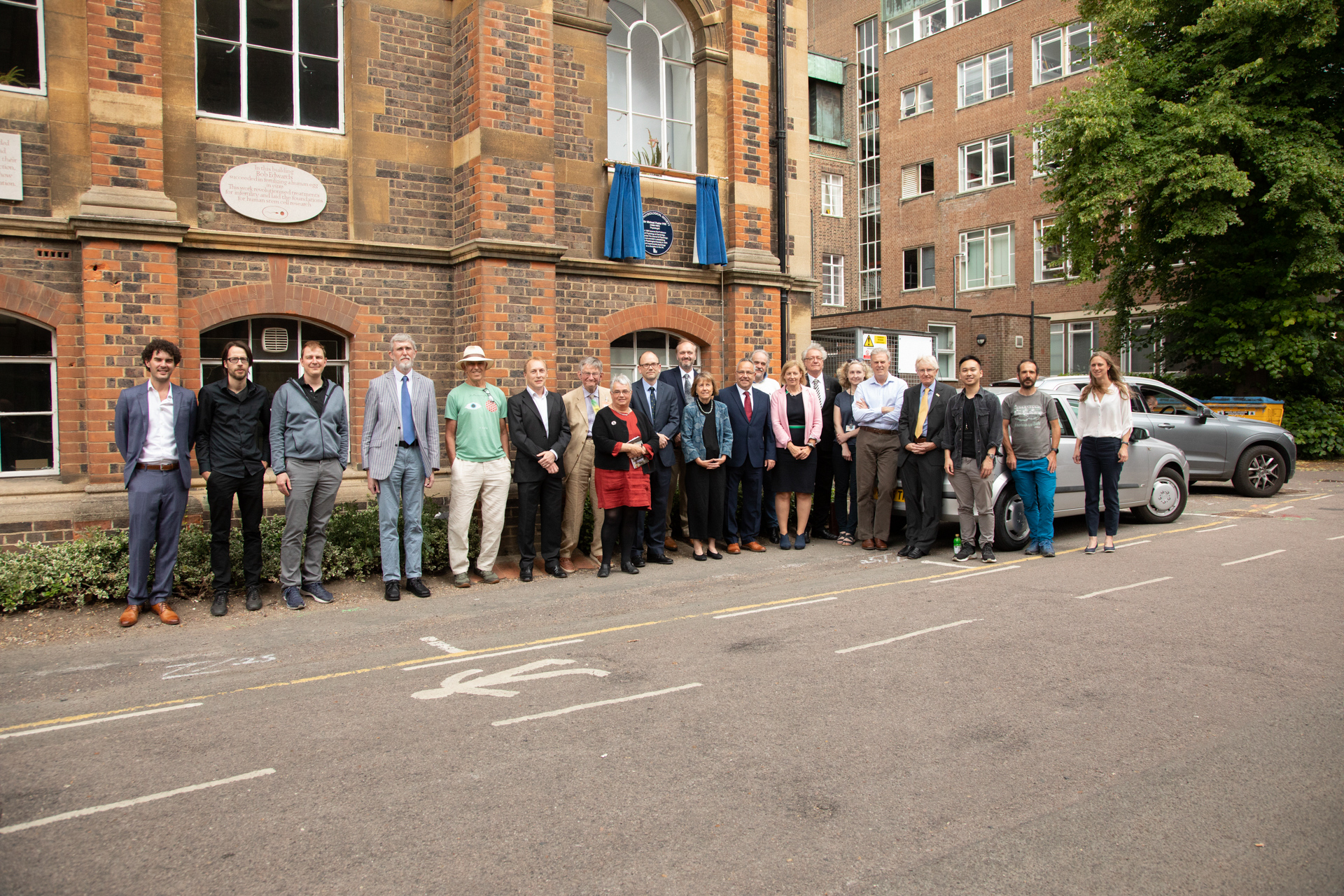
More information on Sir Michael Foster:
Foster was one of 19 physiologists who gathered at the house of John Burdon on March 1876 to form The Physiological Society for ‘promoting the advancement of physiology and facilitating the intercourse between physiologists’. In 1878, he founded The Journal of Physiology, which has published ground-breaking discoveries and the research of noble prize winners.
After a few years of practising medicine as a doctor, Foster switched to a career as a scientist and educator. The transition was initiated by his former teacher, Professor William Sharpey, who invited Foster to give a practical course in physiology at University College London. Foster went onto lead the physiology course at Trinity College at the University of Cambridge, recommended for the position by Professor Thomas Henry Huxley. To have a course dedicated to physiology was itself innovative at the time, as physiology had been deemed as a supplement for the study of human anatomy.
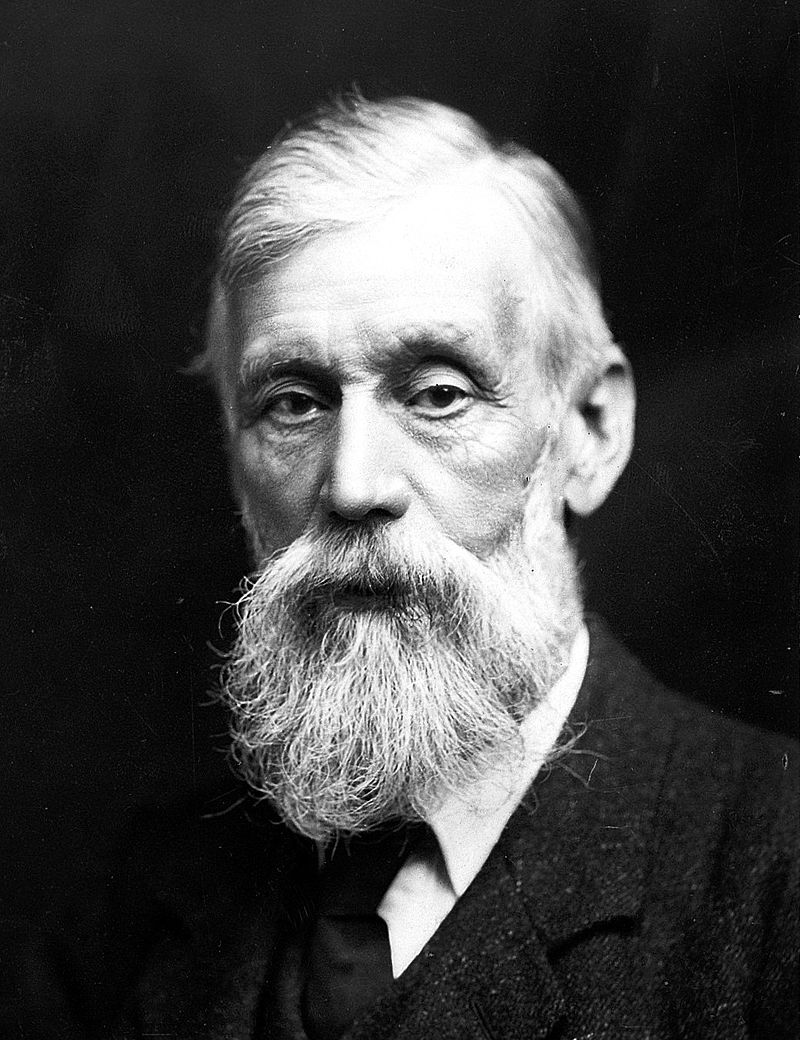
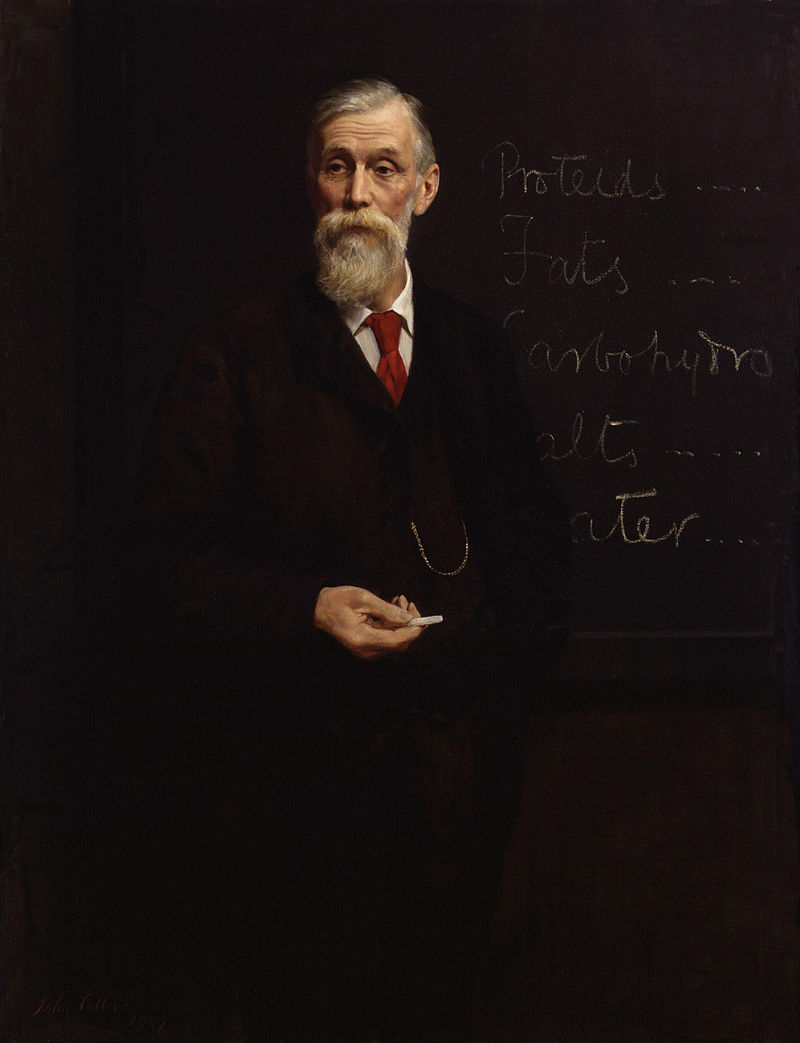
Images in the public domain.
In his role as Praelector and as Chair of Physiology at University of Cambridge, Foster began a new era where physiology was learnt through experimentation. His course at the university involved a laboratory programme that complimented his lectures. By 1914, the Biological School of Cambridge was established and became one of the best centres of physiological research in the world.
Foster excelled at teaching, inspiring his students to devote their lives to physiology. His pupils included the following famous physiologists, Walter Holbrook Gaskell, John Newport Langley, Albert George Dew-Smith and Sir Charles Scott Sherrington who went on to win the Nobel Prize in 1932. Foster wrote the ‘Textbook of Physiology’, which was published in 1877. It was recognised for its superior quality compared to other texts and became a standard work.
Professor Thomas Graham Brown - Cardiff
Name of person: Professor Thomas Graham Brown
Location of plaque: Cardiff University’s School of Biosciences where he was chair in Physiology until 1947.
Date unveiled: 29 September 2022
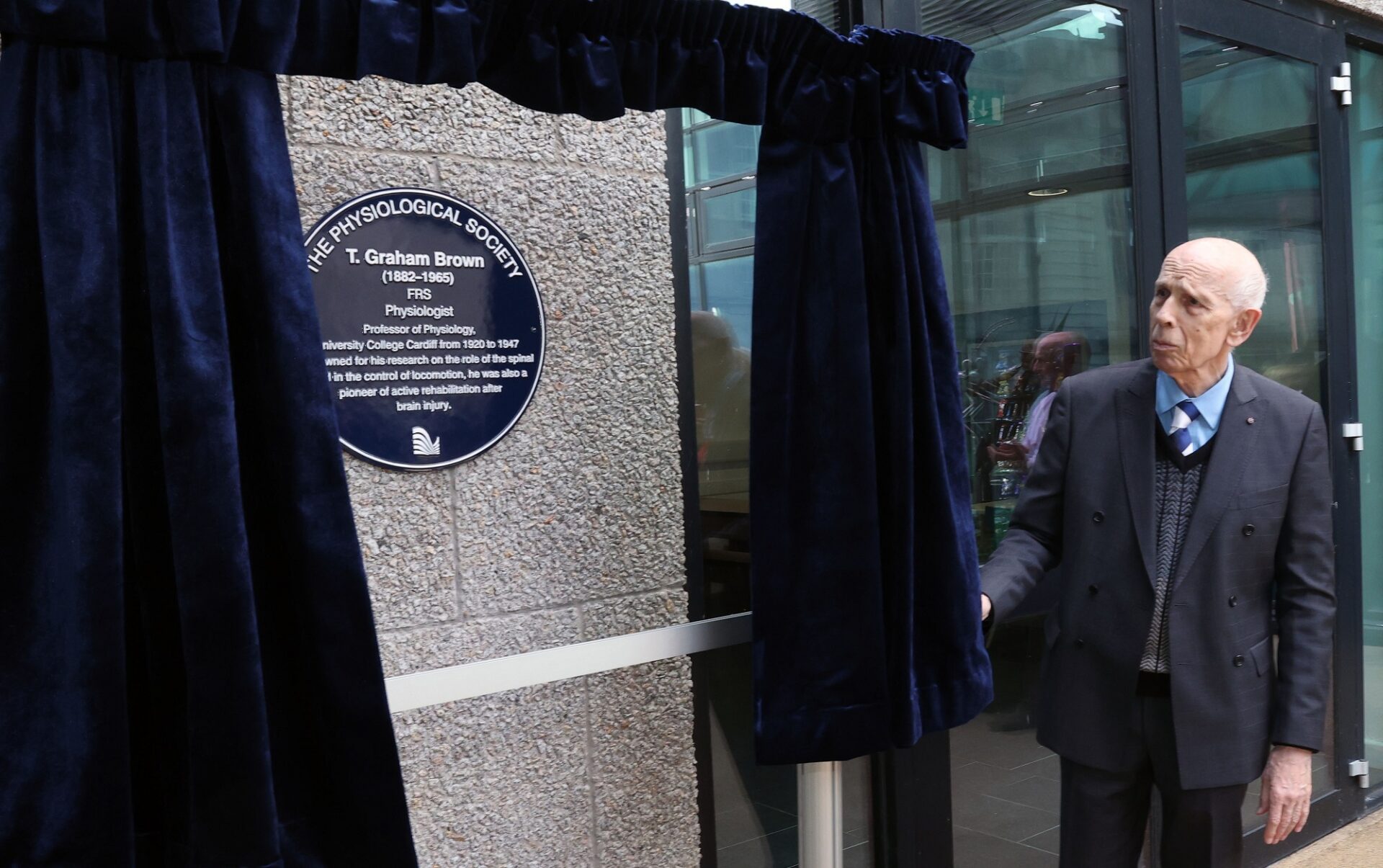
The plaque was unveiled by Professor Ole Peterson of Cardiff University.
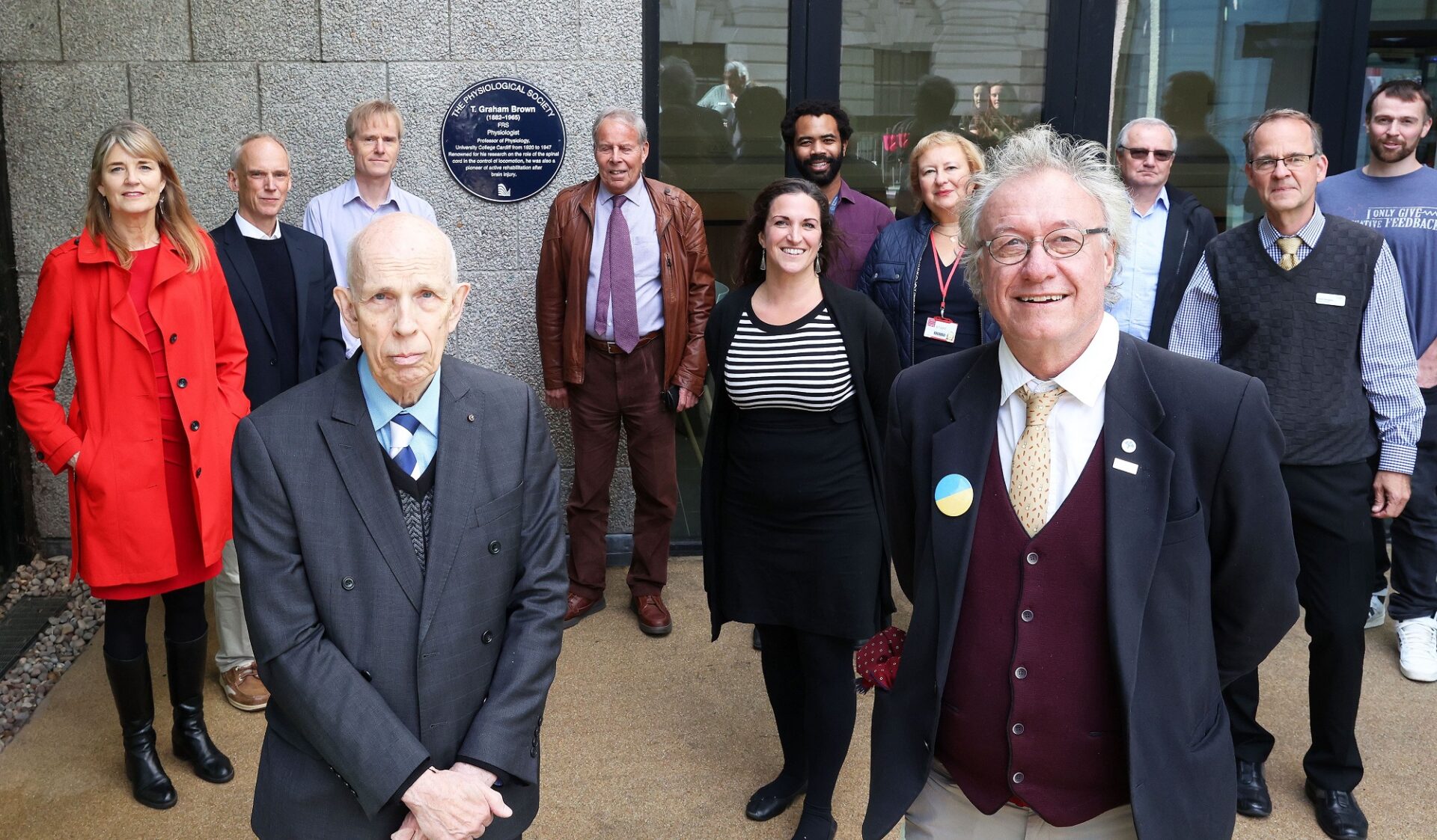
While at the University of Wales in Cardiff, Graham Brown was also head of the then new Cardiff Institute of Physiology (CIP). He oversaw considerable growth in the reputation of what would become the University of Wales College of Medicine, now known as Cardiff University School of Medicine.
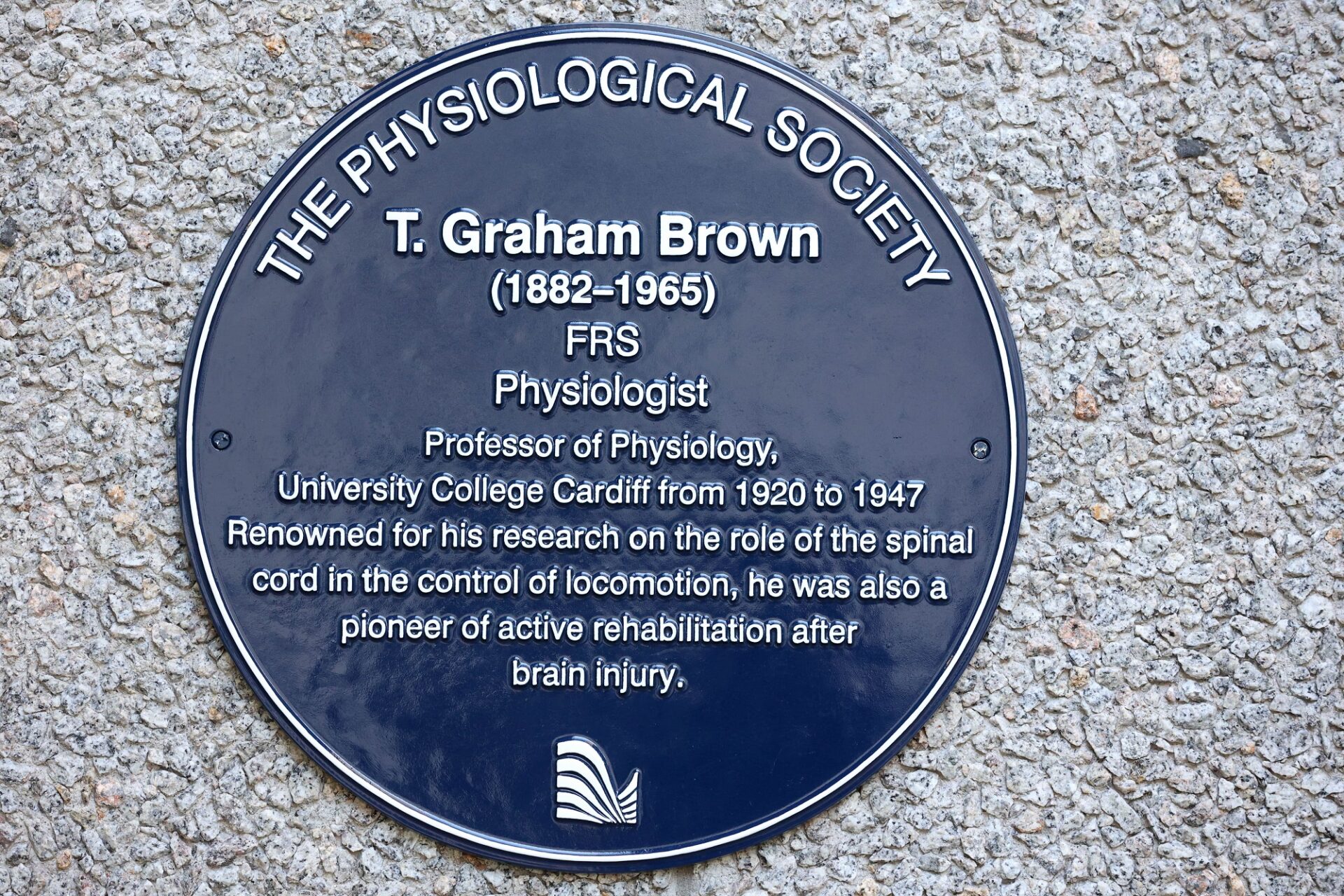
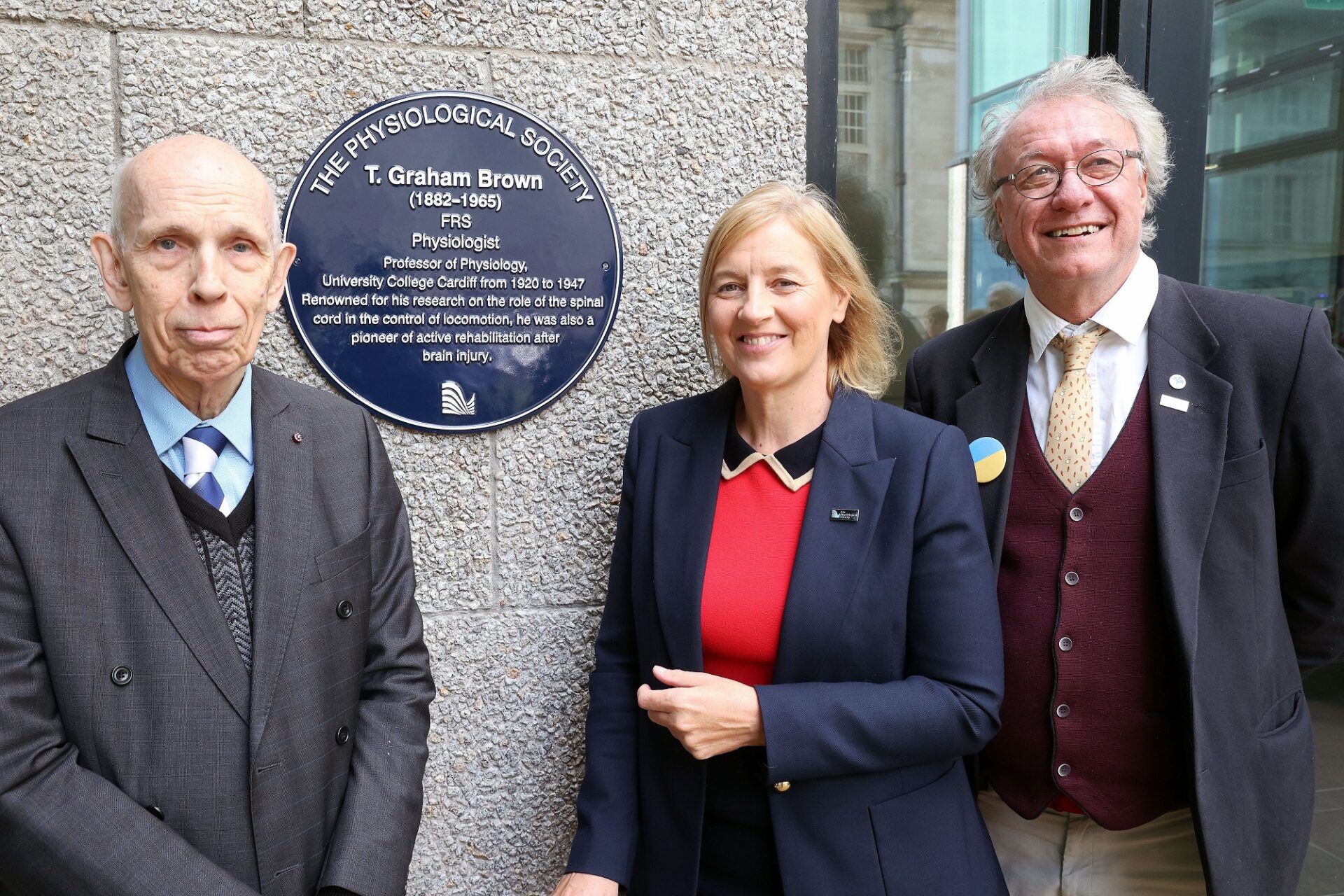
Professor David Paterson, President of the Physiological Society, said,
We are honoured to be in Cardiff to unveil this plaque to remember Professor Thomas Graham Brown. This is the fourteenth unveiling in The Physiological Society’s Blue Plaque scheme which is intended to raise the visibility of physiology and give the wider public an insight into the positive role that ‘the science of life’ plays in their everyday lives. We hope that these plaques will spark curiosity and help inspire new generations to get involved in the physiological sciences.
More information on Professor Thomas Graham Brown:
Professor Thomas Graham Brown (1882 – 1965) was a physiologist renowned for his neurological research, and a British Alpine climber. In 1920 he was appointed chair in Physiology at the University of Wales in Cardiff, a position he held until 1947. The Physiological Society was honoured this week to unveil a blue plaque to celebrate his life and work. He is best known for his studies on the neural control of rhythmic movement described in a series of papers published in the Quarterly Journal of Experimental Physiology under the general title of ‘Studies in the physiology of the nervous system.’
Professor Graham Brown was most famous for finding three new routes up the east face of Mont Blanc. Images in the public domain.
Professor Graham Brown was the first to propose a half-centre model of motor neurons in which two groups of spinal neurons can produce basic rhythmic movement. His model was ignored at the time of publishing because it opposed Sir Charles Scott Sherrington’s popular theory of movement. It was only acknowledged fifty years later in the 1960s when Professor Graham Brown’s model set the groundwork for the field of motor control and was supported by Professor Anders Lundberg and Professor Elzbieta Jankowska’s research. The theory reflects today’s widely accepted concept of central pattern generators in motor neurons.
Sir John Scott Burdon Sanderson - Oxford
Name of person: Sir John Scott Burdon Sanderson
Location of plaque:
Department of Physiology Anatomy & Genetics, University of Oxford, UK
Date unveiled: 17 October 2022
Professor Denis Noble, University of Oxford UK unveiled plaque, which is positioned at the Burdon Sanderson Cardiac Science Centre at The University of Oxford, UK. Work at the centre is dedicated to the science of normal and abnormal cardiac function.

Sir John Scott Burdon Sanderson was born on 21 December 1828 near Newcastle-upon-Tyne to a well-known Northumbrian family. He completed his medical education at The University of Edinburgh UK and in Paris, before becoming the Medical Officer of Health for Paddington, London, UK in 1856 and later physician to the Middlesex Hospital and the Brompton Consumption hospitals.
In 1871 Sanderson reported that Penicillium inhibited the growth of bacteria, an observation that placed him amongst the forerunners of Alexander Fleming.
In 1882 he was appointed as the first Waynflete Professor of Physiology at The University of Oxford. Sanderson’s appointment was initially controversial, partly because the university spent a large amount of money on his resources and partly because his position entailed experimentation on animals. However, in the same year he was awarded a Royal Medal by the Royal Society in recognition of his research into the electrical phenomena exhibited by plants, the relations of minute organisms to disease, and of his services to pathology and physiology. A year later, under Sanderson’s direction, the Department of Physiology was established at The University of Oxford.
In 1895, Sanderson was appointed Regius Professor of Medicine at The University of Oxford and in 1899 he was appointed a Baronet of Banbury Road in the Parish of Saint Giles, Oxford. A year after resigning his university post, Sanderson died in Oxford on 23 November 1905.


John Boyd Orr - Glasgow
Name of person: John Boyd Orr
Location of plaque: The University of Glasgow, Scotland
Date unveiled: 25 May 2023
The legacy of John Boyd Orr, a prominent figure in the field of physiology, nutritionist and Nobel laureate, was celebrated today with the unveiling of a blue plaque at the University of Glasgow.
The plaque was unveiled by Professor Godfrey Smith, Professor of Cardiovascular Physiology, Director of Innovation, Engagement and Enterprise at The University of Glasgow at the ceremony hosted by The Physiological Society. This prestigious honour serves to memorialise Boyd Orr’s outstanding contributions to science and humanity, further enshrining his legacy in the fabric of the university where his career blossomed.
Professor David Attwell, President of the Physiological Society, said,
“We are honoured to be in Glasgow to unveil this plaque to remember John Boyd Orr. He was the first scientist to find the link between poverty, poor diet and ill-health and his legacy on nutrition has transformed our understanding of the relationship between diet and health. The Physiological Society’s Blue Plaque scheme raises the visibility of physiology and gives the wider public an insight into the positive role that ‘the science of life’ plays in their everyday lives. We hope that these plaques will spark curiosity and help inspire new generations to get involved in the physiological sciences.”
Professor Godfrey Smith, Professor of Cardiovascular Physiology, School of Cardiovascular and Metabolic Health, University of Glasgow, said,
“I’m delighted to honour one of the University of Glasgow’s most distinguished alumni, John Boyd Orr, who made vital links between human physiology and nutrition and laid important groundwork for improving human health.”
An exceptional line-up of speakers paid tribute to Boyd Orr’s enduring impact on physiology and nutrition science during the ceremony. Professor Ronald Baxendale, Dr Stuart Gray and Dr Ada Garcia talked about Orr’s research and its current implications linking diet and health.
John Boyd Orr, born in Kilmaurs, Ayrshire, in 1880, made significant contributions to the understanding of nutrition and its effects on human health. His visionary work earned him the Nobel Peace Prize in 1949 for his advocacy of improved nutrition as a pathway to world peace. As a Glasgow University alumnus, his endeavours have left an indelible mark on the institution.
The Physiological Society, a professional body dedicated to promoting the study of physiology, organised this historic event to honour Boyd Orr’s pioneering spirit. The blue plaque serves as an enduring symbol of his profound impact on science and society at large.
Students, faculty, and the general public joined in the celebration of this remarkable figure in physiology and took part in the unveiling of a fitting tribute to his outstanding achievements.
Ernest Starling - London
Name of person: Ernest Starling
Location of plaque:King’s College London, Guy’s Campus
Date unveiled: 22 June 2023
On Thursday 22 June 2023, in honour of the influential physiologist Ernest Starling, The Physiological Society dedicated a commemorative blue plaque at King’s College London, Guy’s Campus. The plaque was unveiled to an audience of researchers, students, and followers of Starling’s work.
Ernest Starling (1866–1927) was a British physiologist and medical doctor known for his pioneering research in heart function and fluid balance. He trained in medicine and taught at Guy’s Hospital. His groundbreaking work led to the formulation of the “Starling’s Law of the Heart,” which showed the relationship between heart muscle stretch and cardiac output. Starling’s other contributions include the concept of hormones, pioneering the understanding of how a substance produced in one part of the body can make a specific response elsewhere in the body. His work profoundly impacted medicine and continues to inform modern physiology.
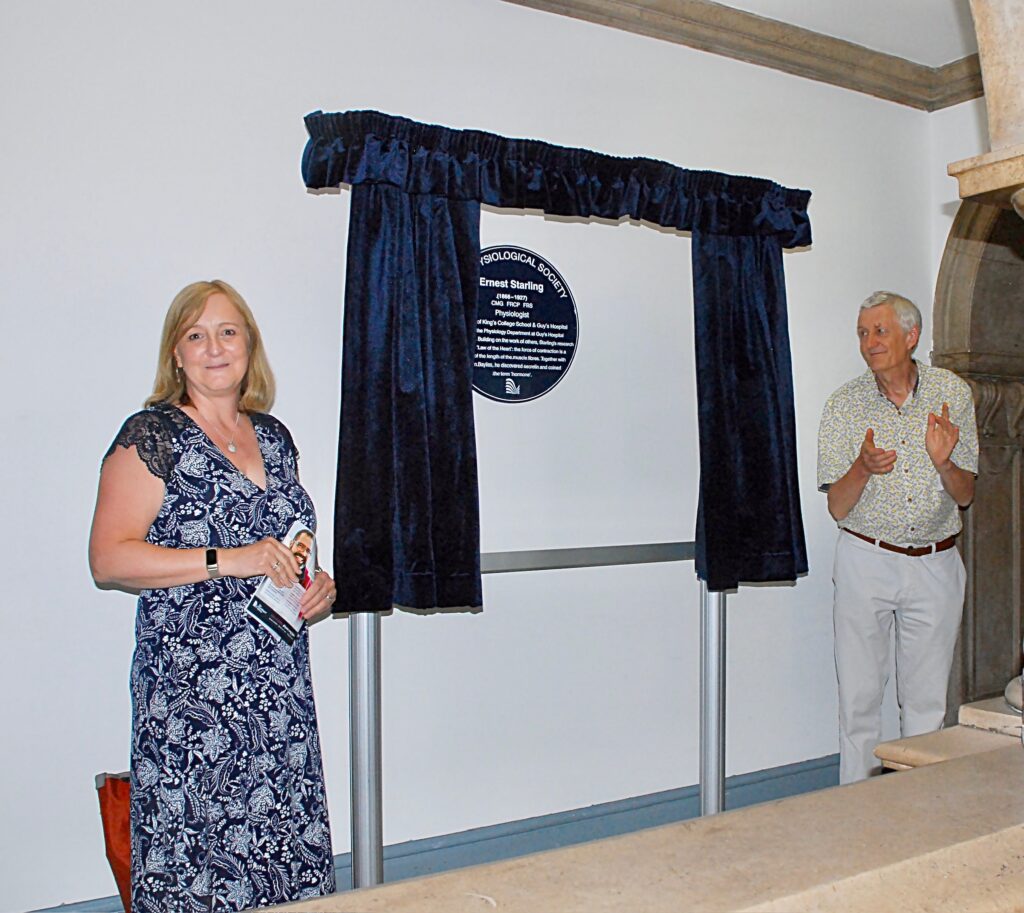
The event included talks from academics from King’s College London. In his talk titled “Ernest Starling at the Heart of Medical Education,” Professor Mike Shattock explored the influence of Starling’s work on contemporary medical teachings. Dr Fulye Argunhan talked about the contribution of Starling’s work to our understanding of heart disease. Finally, Alice Arcidiacono, a PhD candidate, examined the molecular foundation of the “Frank-Starling Law of the Heart.”
By commemorating Ernest Starling at King’s College London, The Physiological Society reiterates its dedication to acknowledging key figures in the discipline, acting as a reminder of our scientific roots and that physiology continues to change the world.
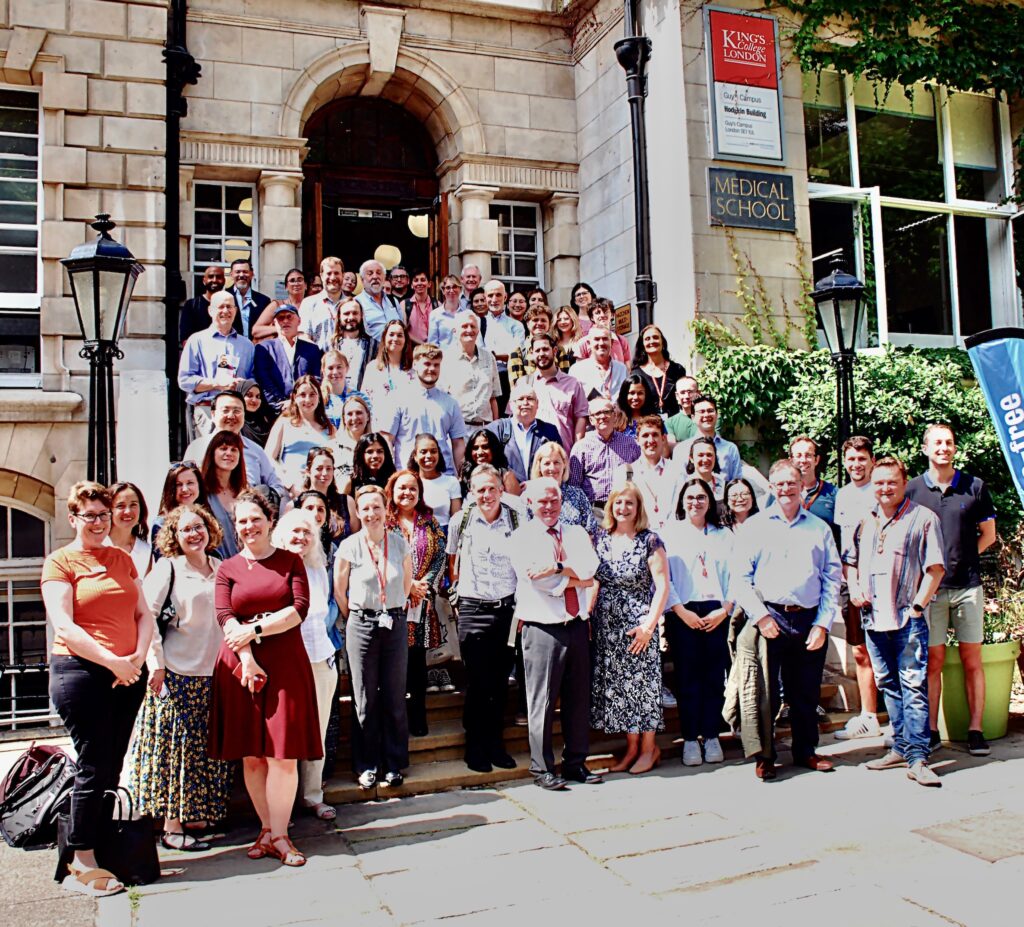
Following the plaque unveiling, Professor David Attwell, President of the Physiological Society, said:
“We are honoured to be at Kings College London to unveil this plaque to remember Ernest Starling. He was the first physiologist to discover the action of hormones, and his work on how the heart works was groundbreaking.
“The Physiological Society’s Blue Plaque scheme raises the visibility of physiology. It gives the wider public an insight into the positive role that ‘the science of life’ plays in their everyday lives.
“We hope these plaques will spark curiosity and help inspire new generations to get involved in the physiological sciences.”
Professor Rachel Tribe, Vice Dean (Research & Impact) and Professor of Maternal and Perinatal Sciences at Kings College London unveiled the plaque and said:
“Ernest Starling is part of the pioneering and physiological heritage of King’s College and Guy’s and St Thomas’ Hospitals, and it is fitting that The Physiological Society is honouring him in this way.”
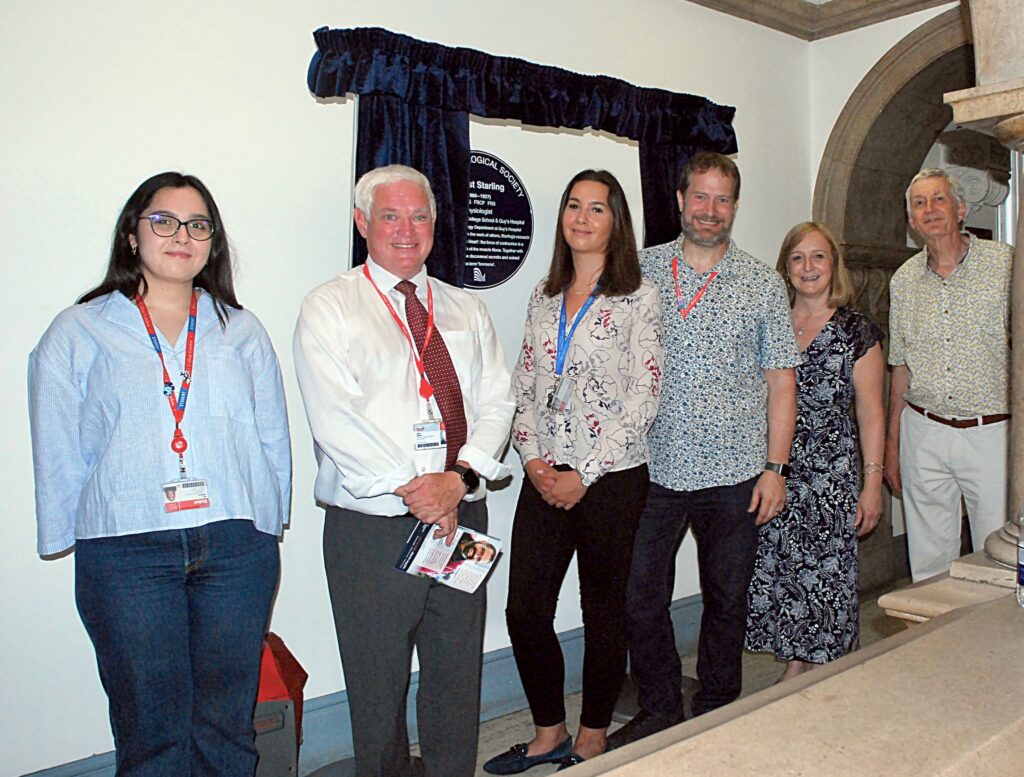
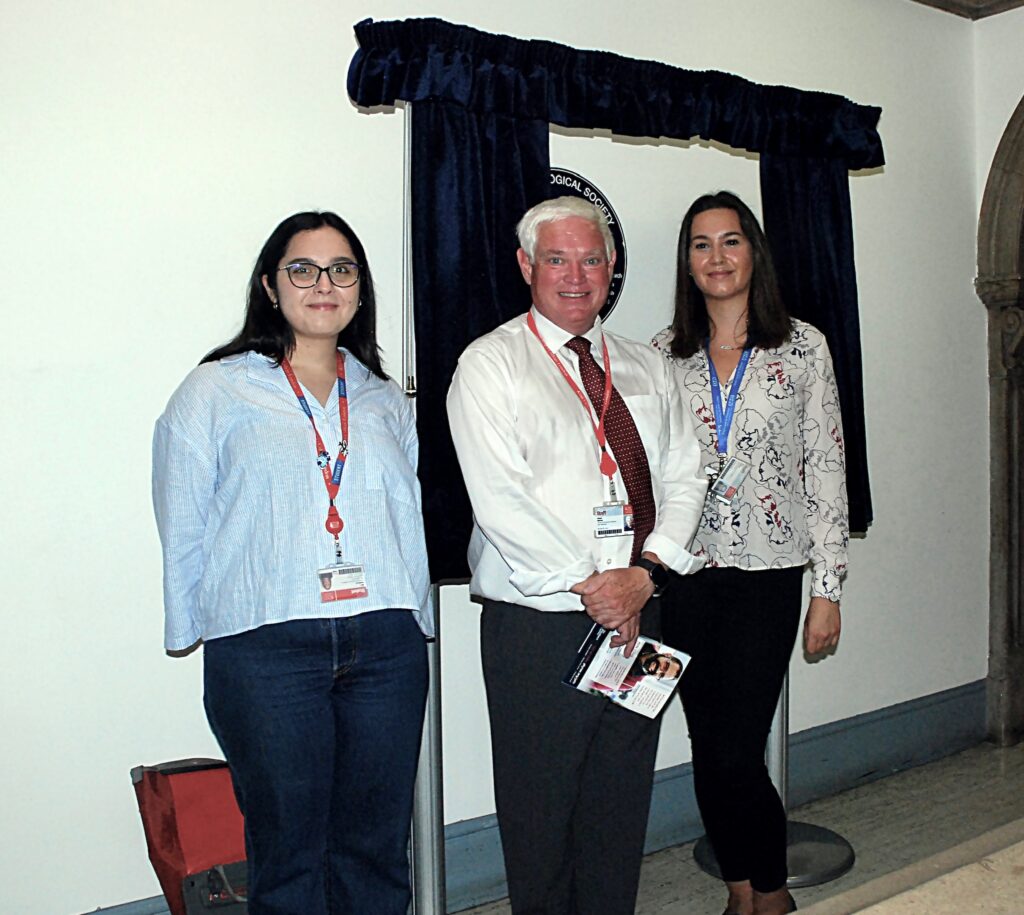
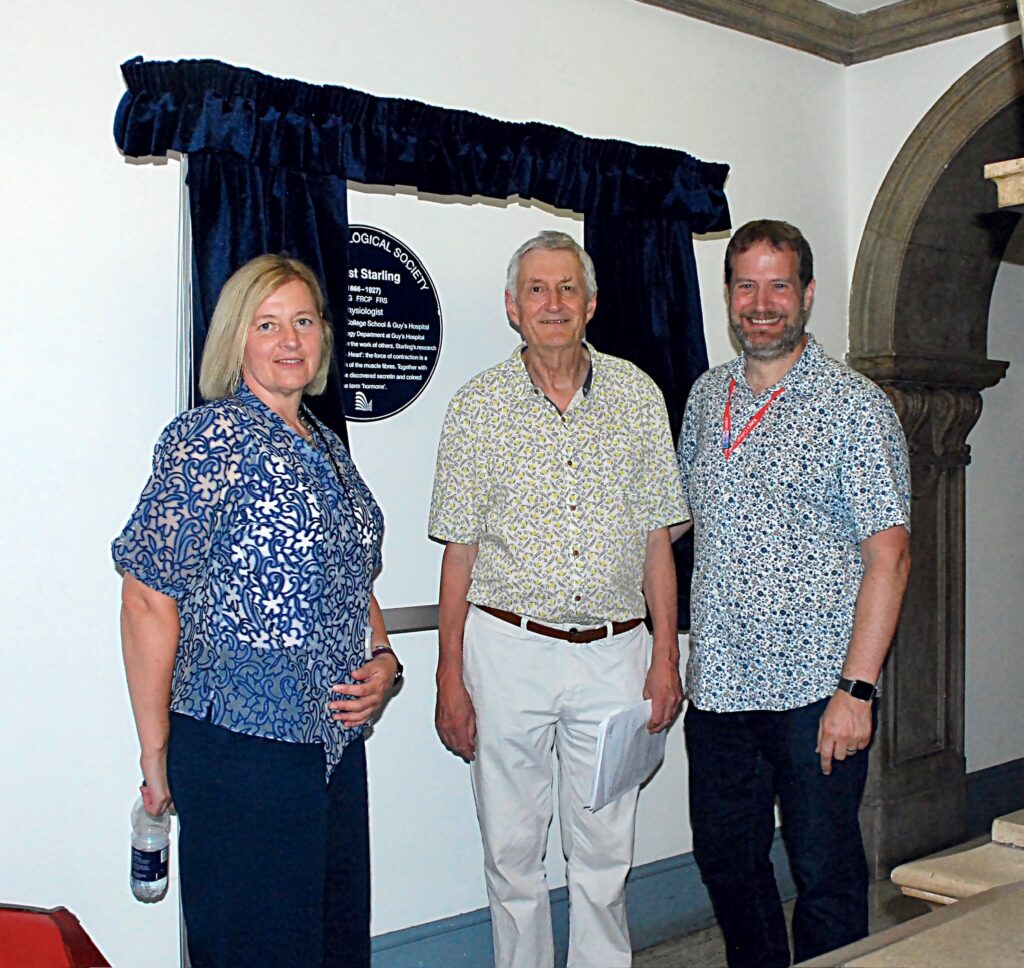
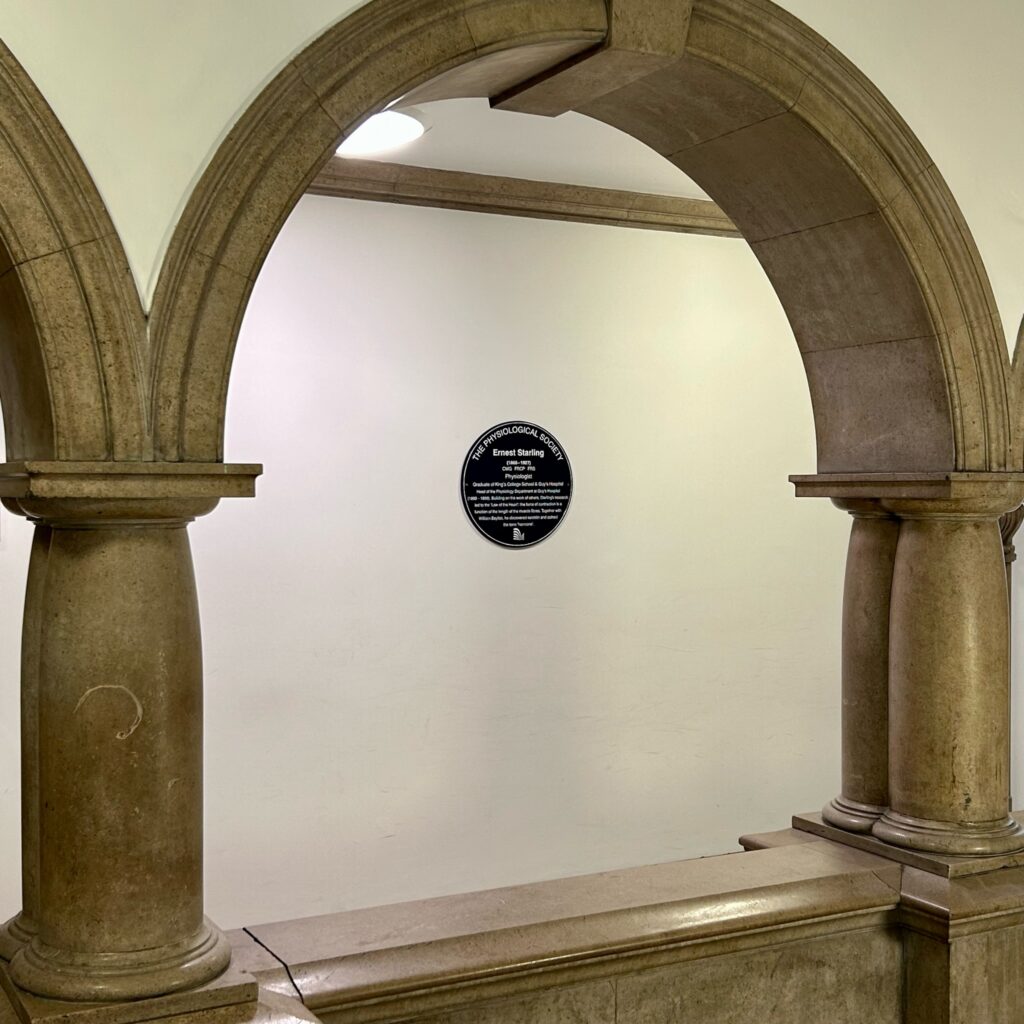

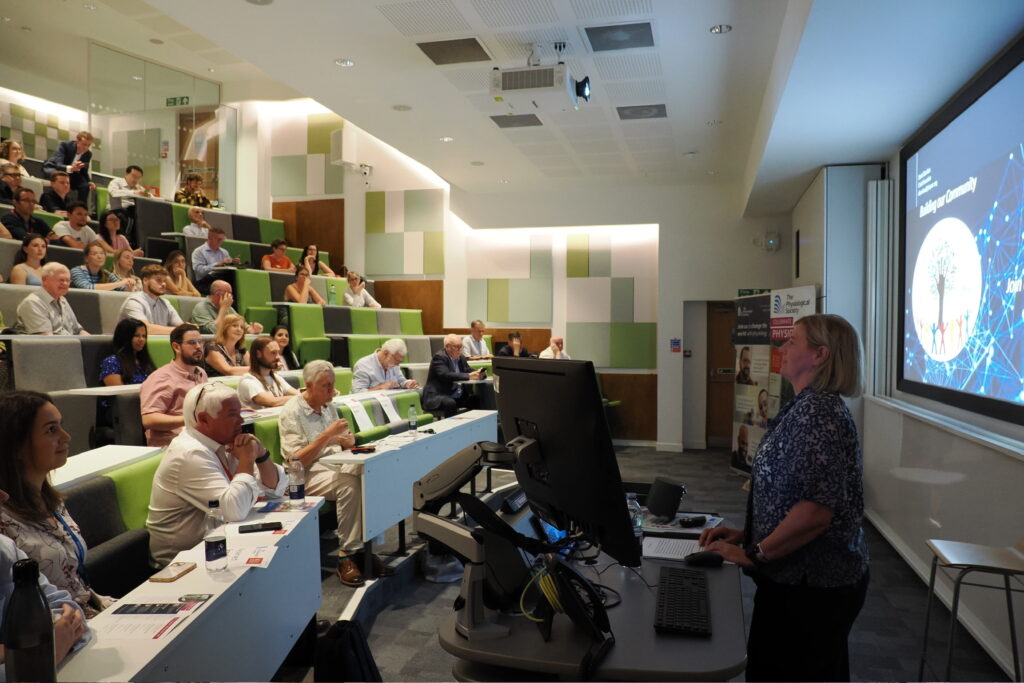


Francis Arthur Bainbridge - Newcastle
Name of person: Francis Arthur Bainbridge
Location of plaque: Newcastle University,UK
Date unveiled: 28 September 2023
The Physiological Society today dedicated a commemorative blue plaque in honour of the outstanding cardiac and exercise physiologist Francis Arthur Bainbridge. The plaque is displayed at the Medical School at Newcastle University.
Francis Arthur Bainbridge (1874 – 1921) is best known for the work he conducted whilst in Newcastle showing how heart rate is controlled. In 1915, he reported that an increased volume of blood returning to the heart caused chamber distension and a resultant increase in heart rate. This phenomenon has become known as the “Bainbridge reflex”.
As well as his pioneering work in exercise physiology, Bainbridge uncovered the mechanism of lymph formation (a fluid that flows through the body’s immune system) and made important contributions to the functional mechanisms of the gall bladder. He also provided new insight into the different strains of salmonella bacteria that can cause typhoid fever and paratyphoid fever.
Following the plaque unveiling, Professor David Attwell, President of the Physiological Society, said:
“We are honoured to be at Newcastle University to unveil this plaque to remember Francis Arthur Bainbridge, and his remarkable contribution to exercise physiology, as well as his interest in understanding the secrets of our body’s organs and systems.
“The Physiological Society’s Blue Plaque scheme raises the visibility of physiology. It gives the wider public an insight into the positive role that ‘the science of life’ plays in their everyday lives.
“We hope these plaques will spark curiosity and help inspire new generations to get involved in the physiological sciences.”
Professor David Burn, Newcastle University, unveiled the plaque and said:
“It is an honour to unveil this plaque dedicated to Francis Arthur Bainbridge, who made important contributions to cardiac physiology and beyond whilst at Newcastle. He is most famously known for the ‘Bainbridge reflex’, which remains a fundamental principle in cardiac physiology today.”
By celebrating Francis Arthur Bainbridge, The Physiological Society reiterates its dedication to acknowledging key figures in the discipline, acting as a reminder of our scientific roots and that physiology continues to change the world.
Elsie Widdowson - King's College Hospital
Name of person: Elsie Widdowson
Location of plaque: King’s College Hospital
Date unveiled: 4 June 2025
Additional information regarding Dr. Elsie Widdowson:
- Royal Society Biographical Memoir
- Radio 4 Great Lives
- Wikipedia page
Press release:
Today, The Physiological Society unveiled a blue plaque at King’s College Hospital to honour the pioneering nutritional physiologist and dietitian, Dr Elsie May Widdowson CH CBE FRS, whose groundbreaking work transformed the field of nutrition and public health.
The plaque marks the site where, in 1933, Widdowson began her influential collaboration with Dr Robert McCance in the hospital kitchens—famously challenging his carbohydrate measurements in apples. This bold moment sparked a scientific partnership that would shape the future of nutritional science.
Through documenting the nutritional content of thousands of foods, Widdowson and McCance developed the first comprehensive tables of food composition, which became the foundation for modern dietary guidelines. Their work also laid the groundwork for understanding the long-term effects of childhood nutrition on adult health.
To celebrate Widdowson’s legacy, apple cake – a nod to her early research – was served to all in-patients at King’s College Hospital as part of the hospitality menu. Apple muffins will also be available throughout the week as an alternative snack.
Guests attending the unveiling enjoyed the apple cake as one of the canapés, alongside a sparkling apple drink, adding a celebratory touch to the occasion.
Dr Mamta Shetty Vaidya, Chief Medical Officer at King’s College Hospital NHS Foundation Trust said:
“I’m honoured to help unveil this plaque celebrating Elsie’s legacy. Her pioneering work in dietetics had a profound impact on public health – yet, like so many women, her contributions have often gone unrecognised. Today’s event is a powerful reminder of the need to shine a light on the vital achievements of women throughout history. I’m proud that through the Women’s Network, we are helping to ensure these stories are seen and celebrated.”
Claire Melody, Co-Chair of the Women’s Network and Programme Manager at King’s College Hospital NHS Foundation Trust said:
“I am incredibly proud and humbled by the dedication and effort of the Women’s Network steering group and our colleagues in securing this plaque and organising such a meaningful celebration. This recognition reflects our shared commitment to empowering women and building a supportive, inclusive community. Together, we are helping to shape a more equitable future, and I am honoured to be part of that journey.”
The event also featured talks from leading physiologists and a networking reception. It served as a powerful reminder of the enduring impact of Widdowson’s work and the vital role of physiology in improving lives.
